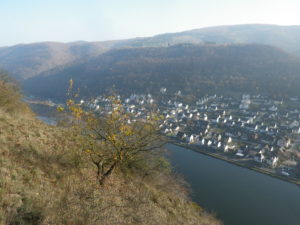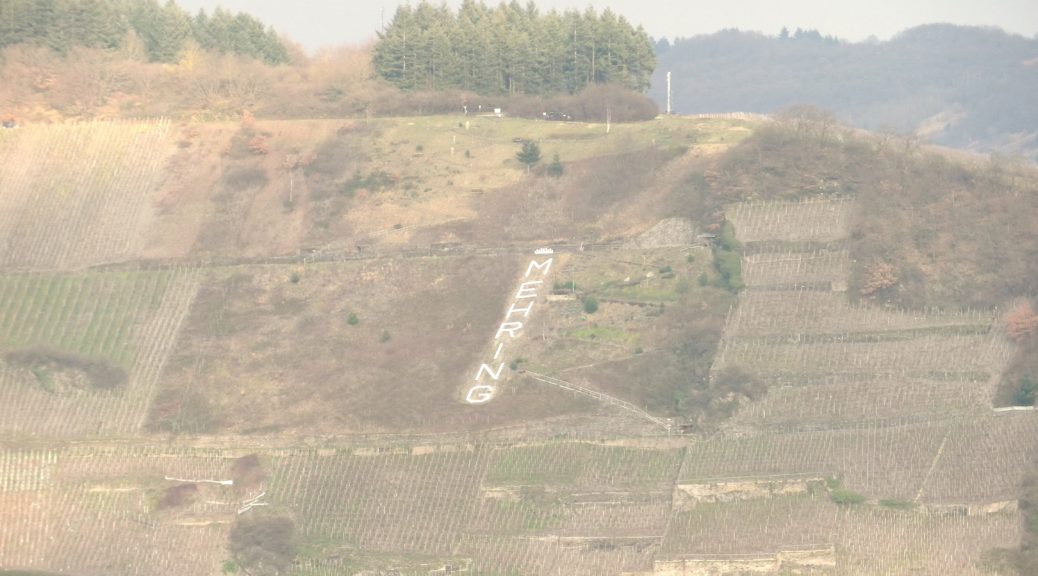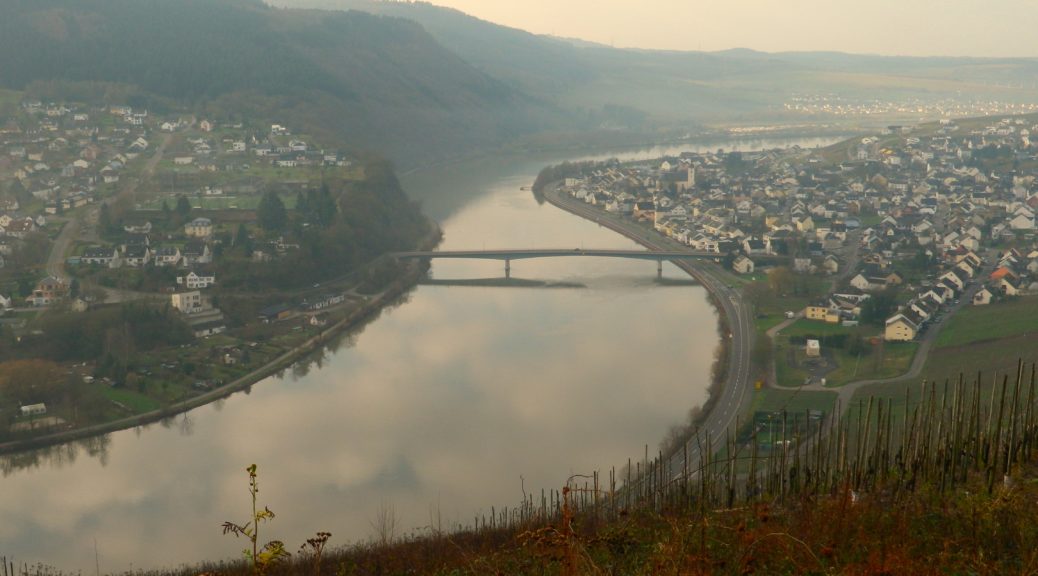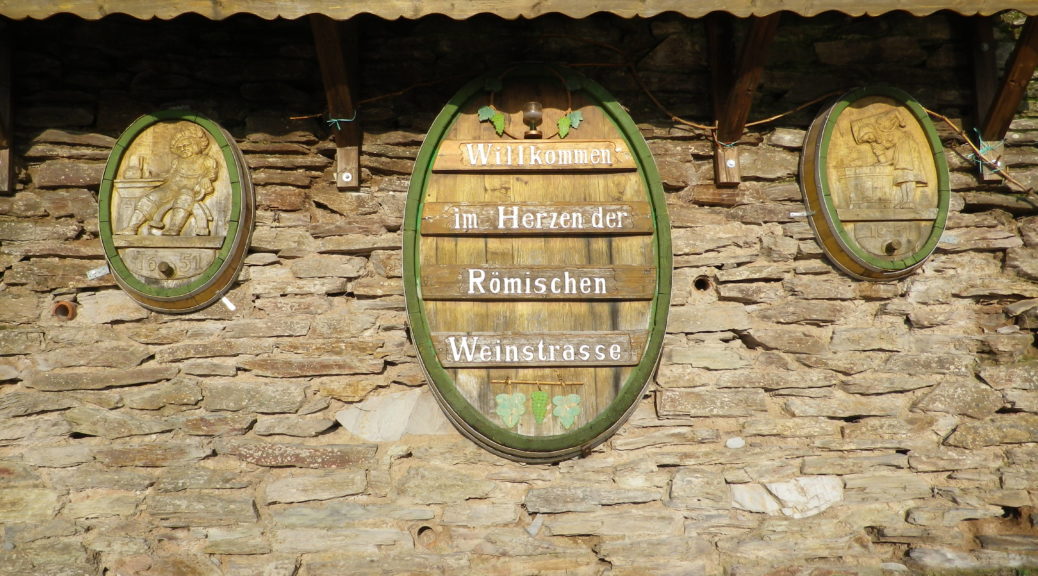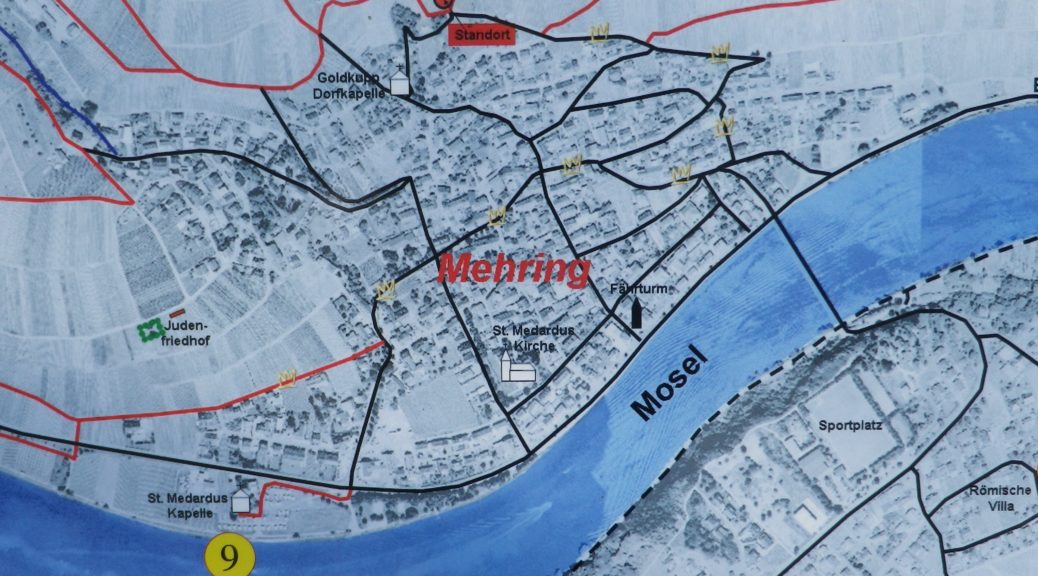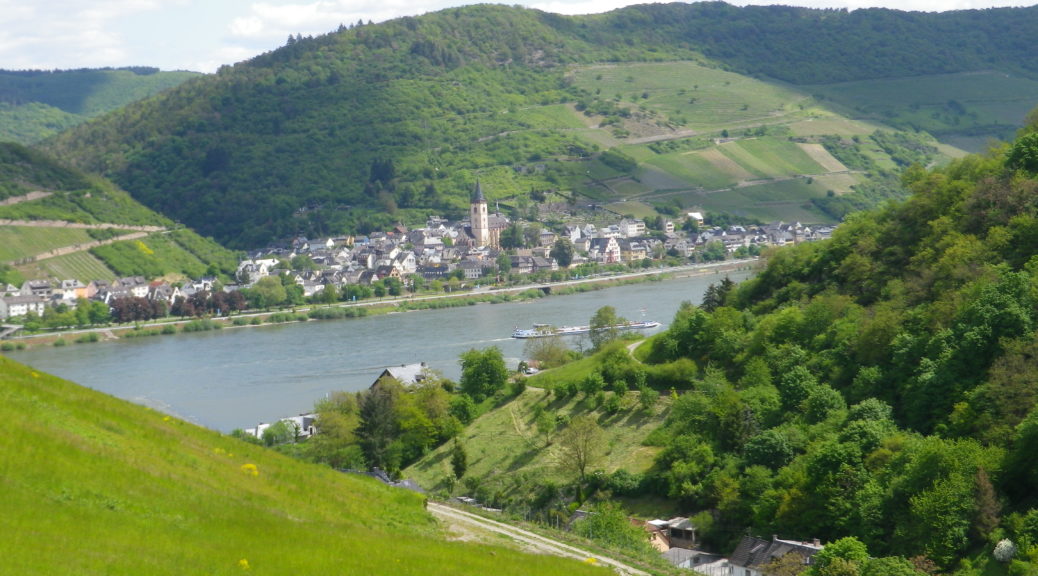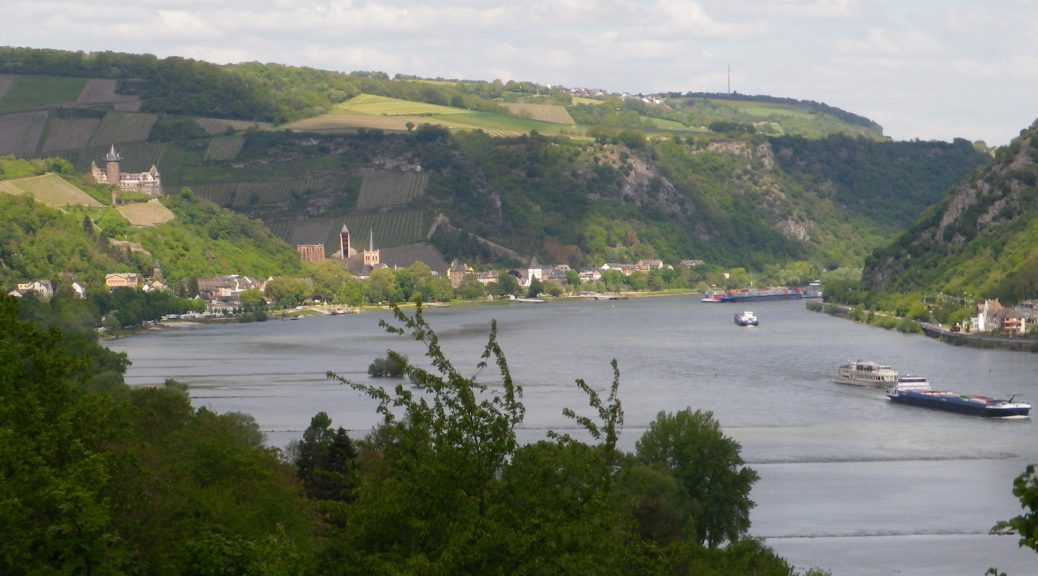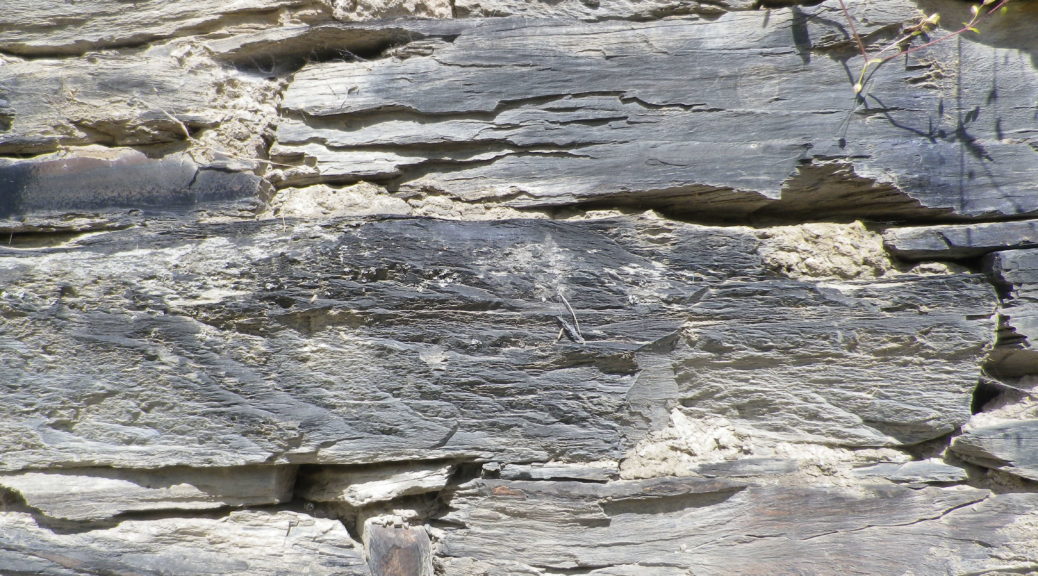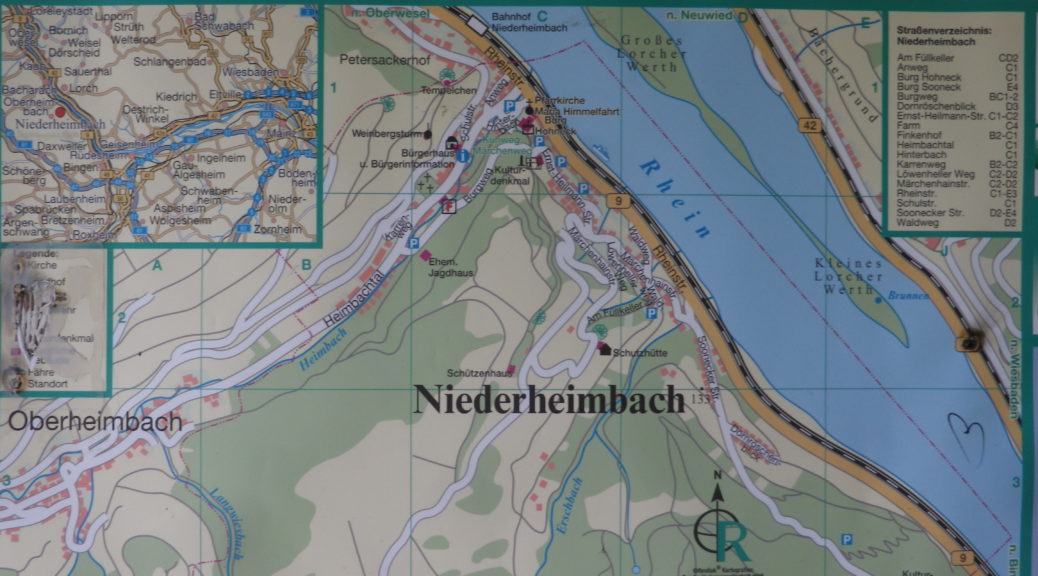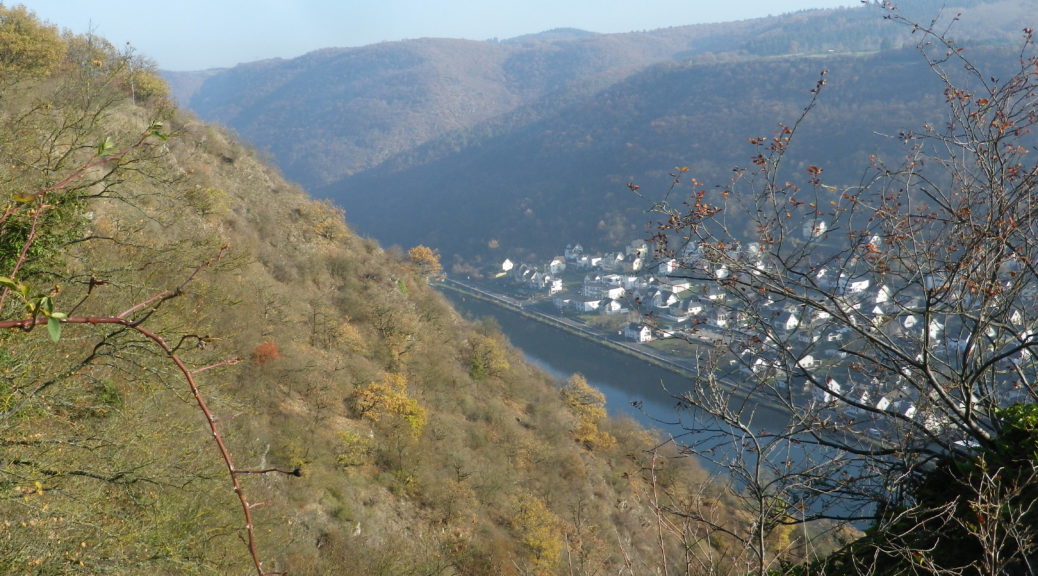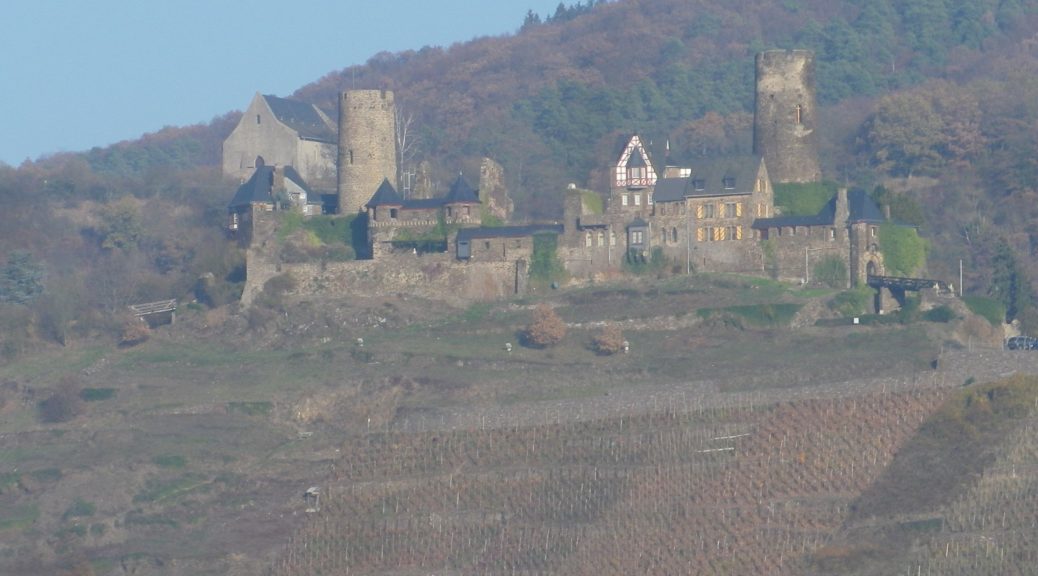Tag Archives: Rheinland-Pfalz
The Old Moselle
Along the Roemische Weinstrasse, that section of the Mosel where Romanitas arguably reached its maximum expression in Germany, there are many reminders of the era that once was, and what it became. For these two reasons alone, the hike along some of the best vineyards found in this stretch of the Moselle was a rewarding experience.
Trier, once the capital of the Roman Empire, is itself worth a hike through the city. A magnificent city gate (Porta Nigra), the basilica of Aula Palatine, an amphitheater, baths, a bridge, impressively show the former grandeur of this city. The nearby village of Mehring also boasts villa ruins dating to that era. In short, back in the day, this city and the surrounding countryside was the place to be. While neither place is as grandiose as it once was, that remains in this area is dedicated wine-making, and impressive views.
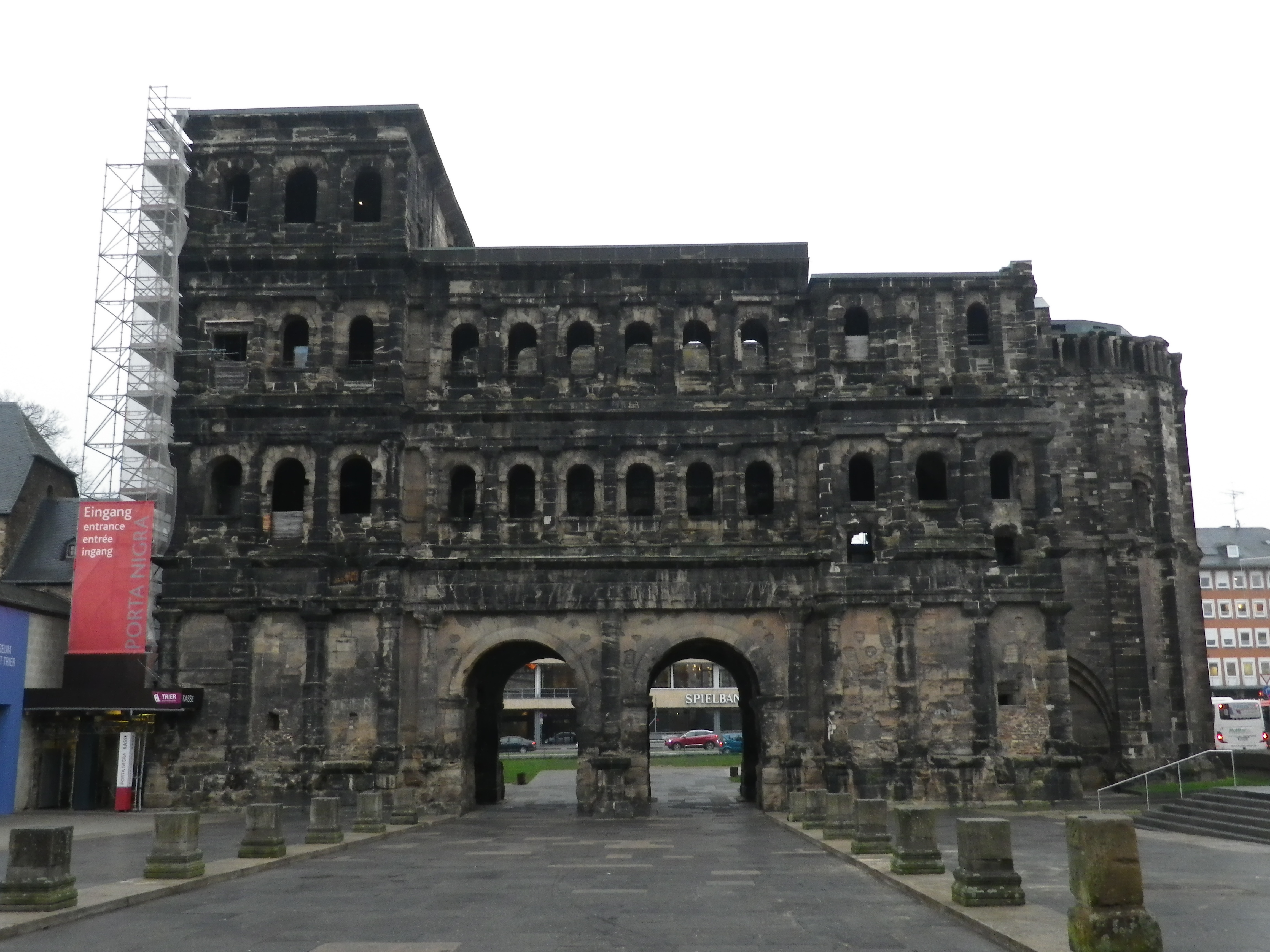
The circuit hike began in the center of Mehring, on the left bank of the Moselle, opposite the former villa. The circuit began with a climb up through the vineyards to the grill hut near the top. A great place to grill and enjoy the view, before continuing on up the hill heading beyond the Blattenberg vineyard toward the Goldkupp one. This is one of the most highly esteemed vineyards in the area, and with its steep slope, and southern exposure, it is favorably sited for vines! Undoubtedly, vines grew here during the Roman era as well.
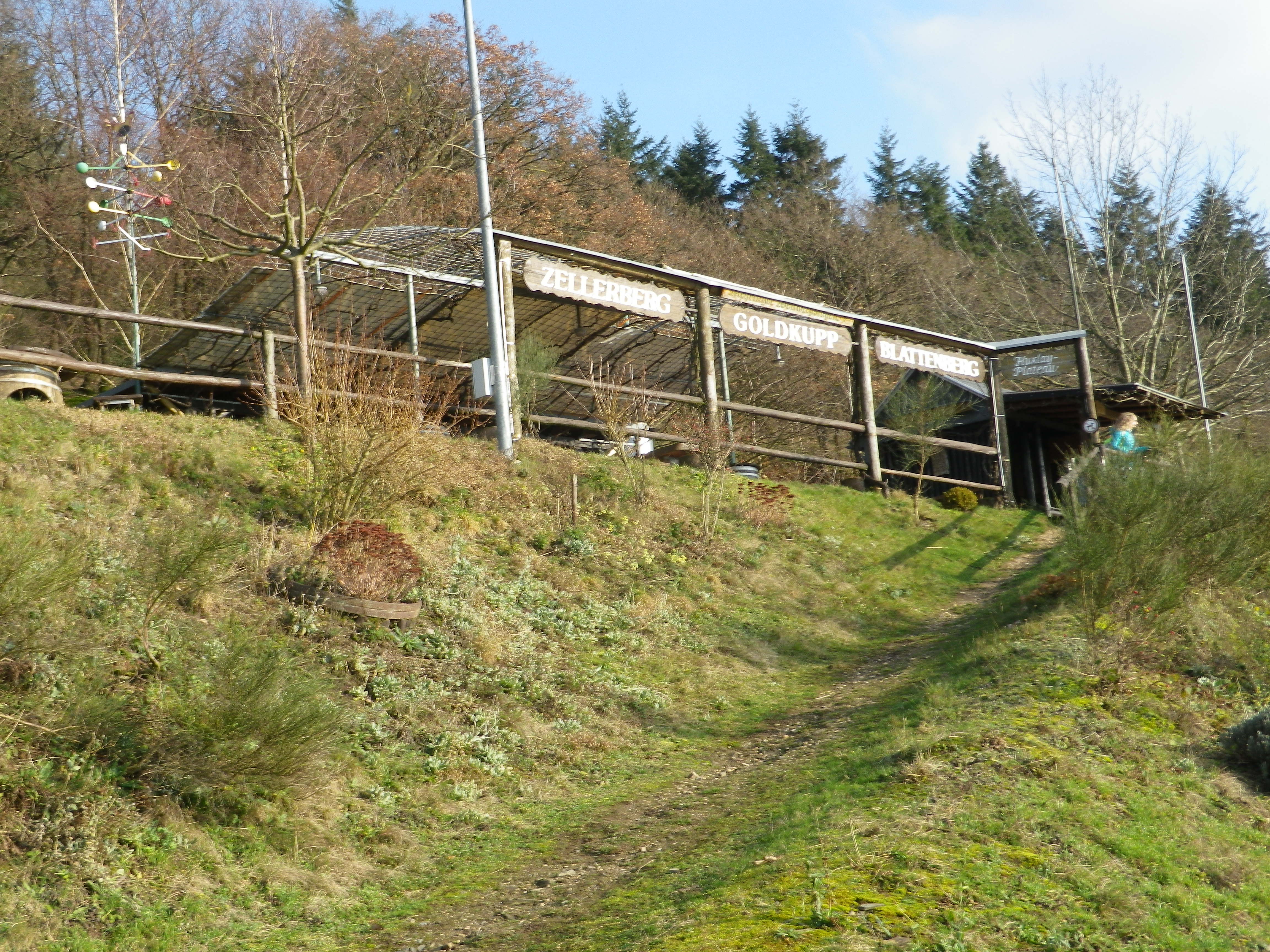
Soon I came to the 10,000 liter wine barrel. Converted into a picnic area, it offers nice views of Goldkupp. Being just above 500 meters below the Ortsberg peak, it also had great views of the river and the hills beyond. It was just possible to make out the Roman villa ruins on the other side of the river. Unfortunately, I had no wine to sip as I admired the views seated at the picnic table.
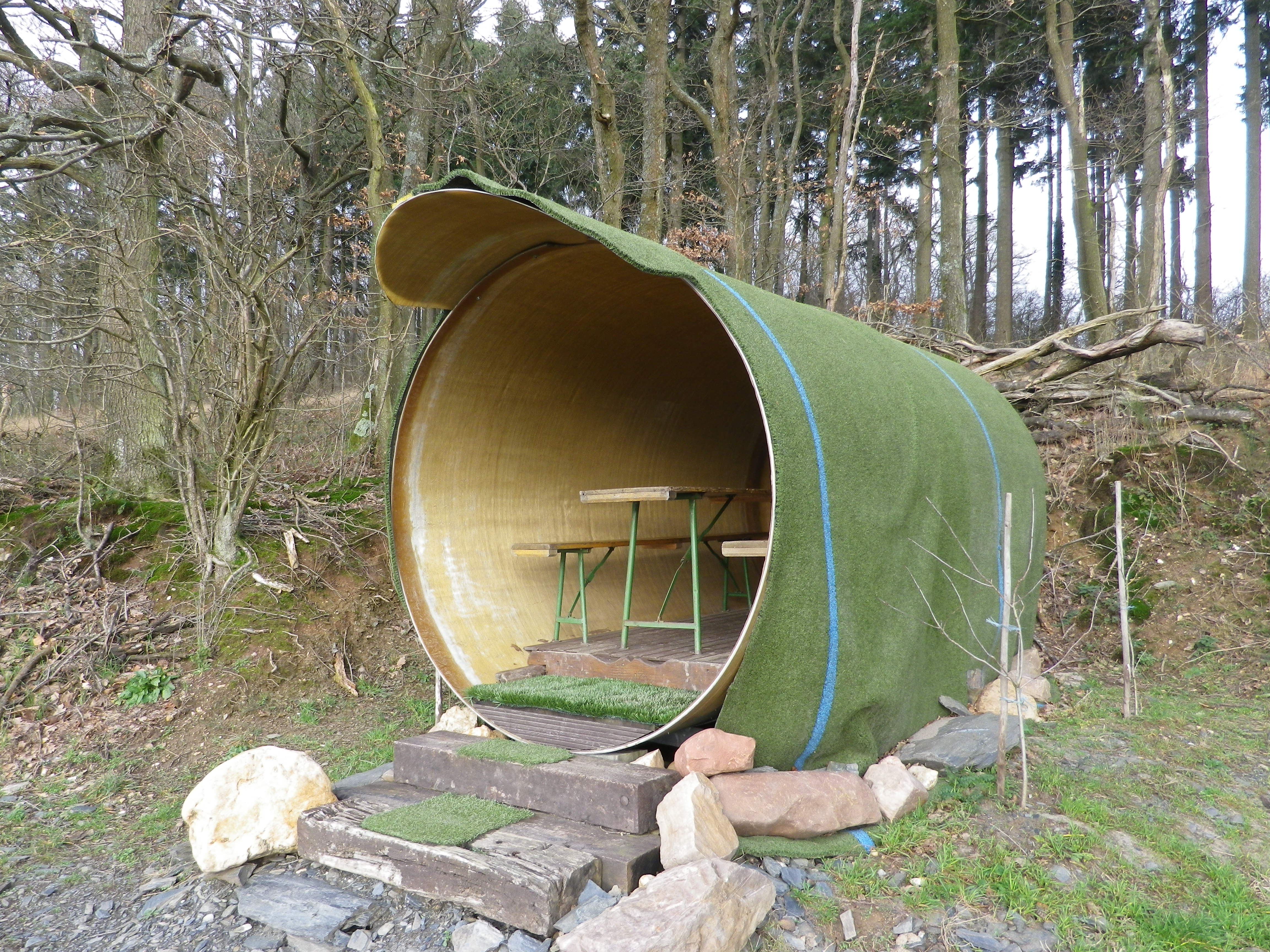
The trail then curved behind the slightly lower Hundsbuckel peak. One nice thing about this trail is that some of it passes through woods, along shady paths that in summer would be a welcome break. Between vines and woods were fields, marginal areas not suited for grapes. Vineyards appeared again on the lower reaches of the slope, just outside of the village. At that point, looking up at the vineyards served to illustrate just how much this village is devoted to wine, how the vines dominate it, as undoubtedly it has for centuries.
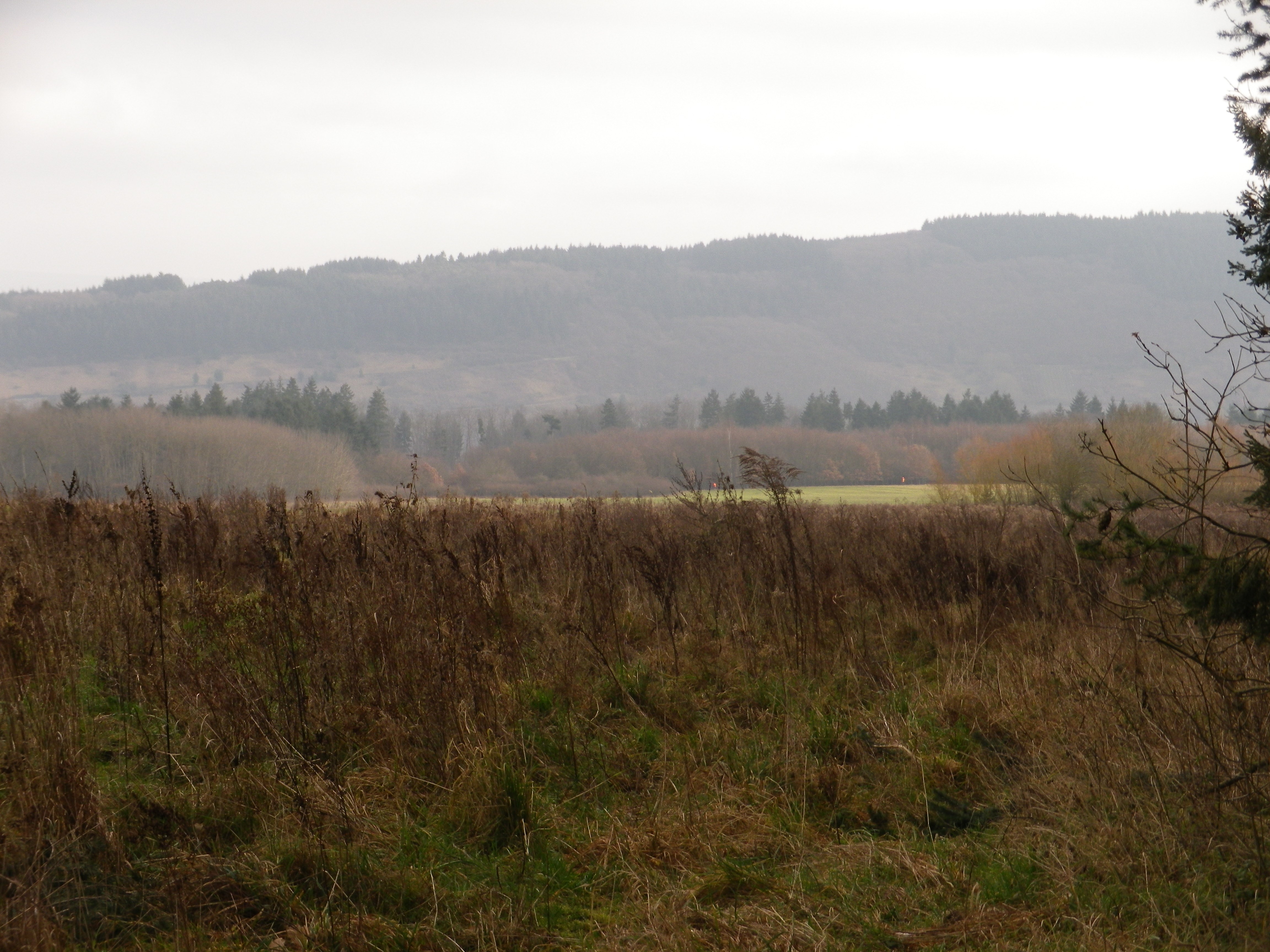
Passing back through the village center on the left bank, one is struck by how medieval it is. You can tell from the street layout. In the mid-eighth century, Charlemagne’s father donated the area to the Prum Abbey, and it then became their most important wine-making place, indicating that Frankish warlords, after taking control from the Roman administration, at least let things continue as they had under the previous administration. (Charlemagne himself, from his old Roman-era villa at Ingelheim, directed that grapes be planted opposite his villa, on the sunny slope, where the “winter snows first melted.”)
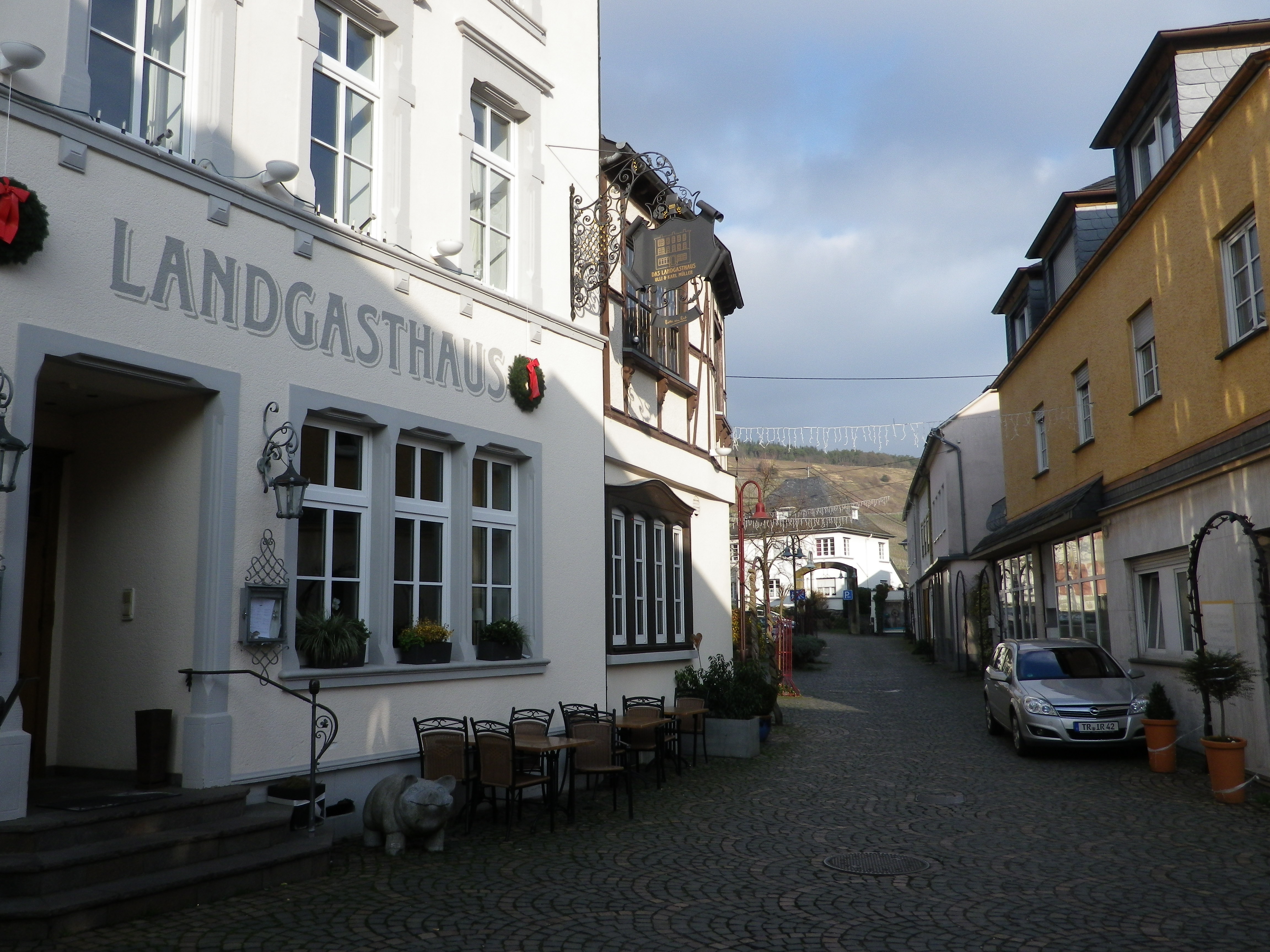
From the village center, taking a small detour to the river is advised. Or even more adventurous, cross the bridge to visit the villa ruins, always open, and worth a visit. From there, I admired the vineyards from afar, and contemplated the good life the owners must have had with their wines in their comfortable villa on this lovely stretch of the upper Moselle. Eons of time and generations of experience helped this lovely district evolve into what it now is, and nowadays it is certainly a place to be seen and savored!
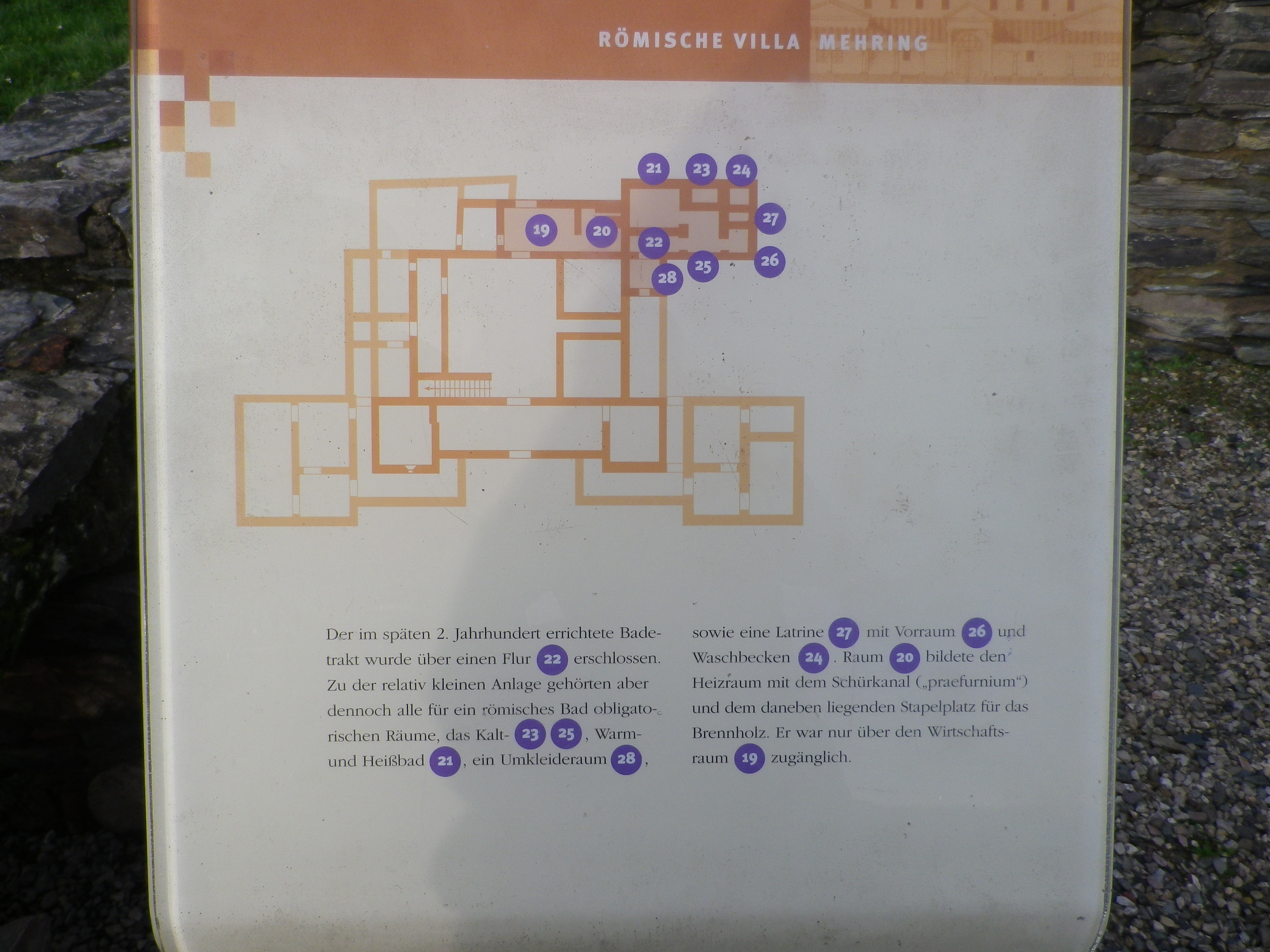
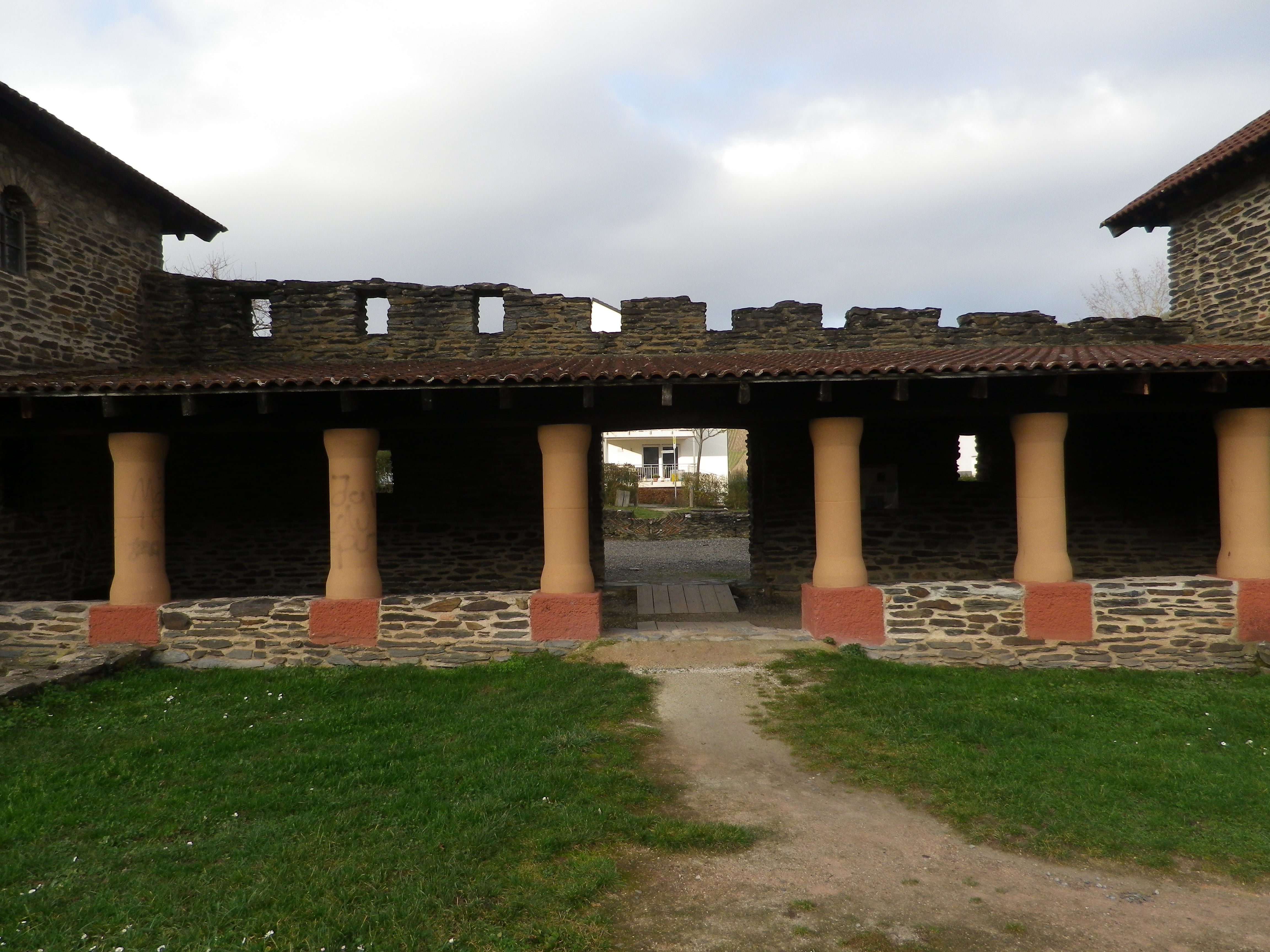
Wine Notes: Bernkastel Moselle
What I Learned
The Mosel (Moselle)-Saar Ruwer Wine Region is a large one. The focus here is the wine growths directly along the Moselle River valley, which is classified into three sections: The Southern (Upper) Moselle area, the Bernkastel (Middle) Moselle area, and the Terraced (Lower) Moselle.
The Upper Moselle (in Germany) begins at the French border, at Perl, opposite the Luxembourg town of Schengen. It follows the river downstream. The soil here is characterized by shell limestone, marl and sediment. The slopes here are fairly gentle, and the Saar River joins into the Moselle at the edge of this zone. This area ends where it abuts against the Bernkastel (Middle) Moselle zone, around the city of Trier. The Ruwer district joins the Moselle above Trier, then the Bernkastel zone begins again by Kenn, and continues uninterrupted almost reaching Zell (Mosel). Most visitors begin their Moselle visits at Bernkastel-Kues, and follow downriver to Zell and Cochem, even to Koblenz on the Rhine, thus missing this southern Bernkastel area completely. In this middle district, I mostly focused on wines from Mehring, and its well-known Goldkupp and Zellerberg vineyards. The area around Trier (famous for Karl Marx and the Romans), produced some interesting wines as well. This is where Roman history and great wine terroir combine to create a compelling experience for wine tourists.
What I Tasted
2017 Riesling Spaetlese, Mehringer Goldkupp, Trocken, Praedikatswein, Weingut Sebastiani (Mehring): A dry white wine with medium minus gold color; floral, mineral nose, with spice mustard, slight turpentine, and fruit flavors, medium plus acidity, with a tart finish.
2017 Riesling, Mehringer Zellerberg, Hochgewaechs, Halb-Trocken, Deutscher Qualitaetswein, Weingut Sebastiani: An off-dry white wine with pale plus gold color; a slightly mineral nose, with green apples, and green gooseberry flavors.
2017 Riesling Auslese, Mehringer Goldkupp, Trocken, Praedikatswein, Weingut Sebastiani: A sweet white wine with medium minus gold color; a ripe, fruity nose, with ripe peach and apricot flavors; mild acidity, and well-balanced overall.
2017 Weissburgunder, Mehringer Zellerberg, Trocken, Deutscher Qualitaetswein, Weingut Sebastiani: A dry white wine with pale gold color; a slight nose of fruit, and green apple flavor, with a hint of minerality; Medium acidity.
2016 Dornfelder, Auf Schock, Trocken, QbA, Weingut Jutta Fassian (Mehring): A dry red wine with dark garnet color; cherry nose with a hint of tobacco, cherry, pipe tobacco and oak flavors; soft, mild tannins, smooth finish, with a velvety mouthfeel.
2016 Riesling, Trierer Sankt Mattheiser, Hochgewaechs, Feinherb, Qualitaetswein, Weingut H. Wahlen (Trier): An off-dry white wine with light gold color, fruity and mineral nose, with floral and ripe peach flavors; medium acidity, smooth, sweet finish.
2015 Spaetburgunder Rose, Halb-Trocken, QbA, Weingut Longen-Schloeder (Longen-Longuich): An off-dry rose with a light cranberry color; slight red berry and floral nose, with red berry and vanilla flavors, hint of stone-mineral; smooth finish.
Mehring R5: Trail in a Nutshell
Trail Name: Roemische Weinstrasse Mehring R5
Trail Type: Short distance circuit; well-maintained and almost exclusively paved, marking on the trail mostly good
Length:
Total – 9.8 kilometers/ 6.08 miles
Convenient to: Trier, Germany
Marking:
White and yellow metal square with lettering R5 in black, stylized hikers; and/or directional arrows with trail number on posts
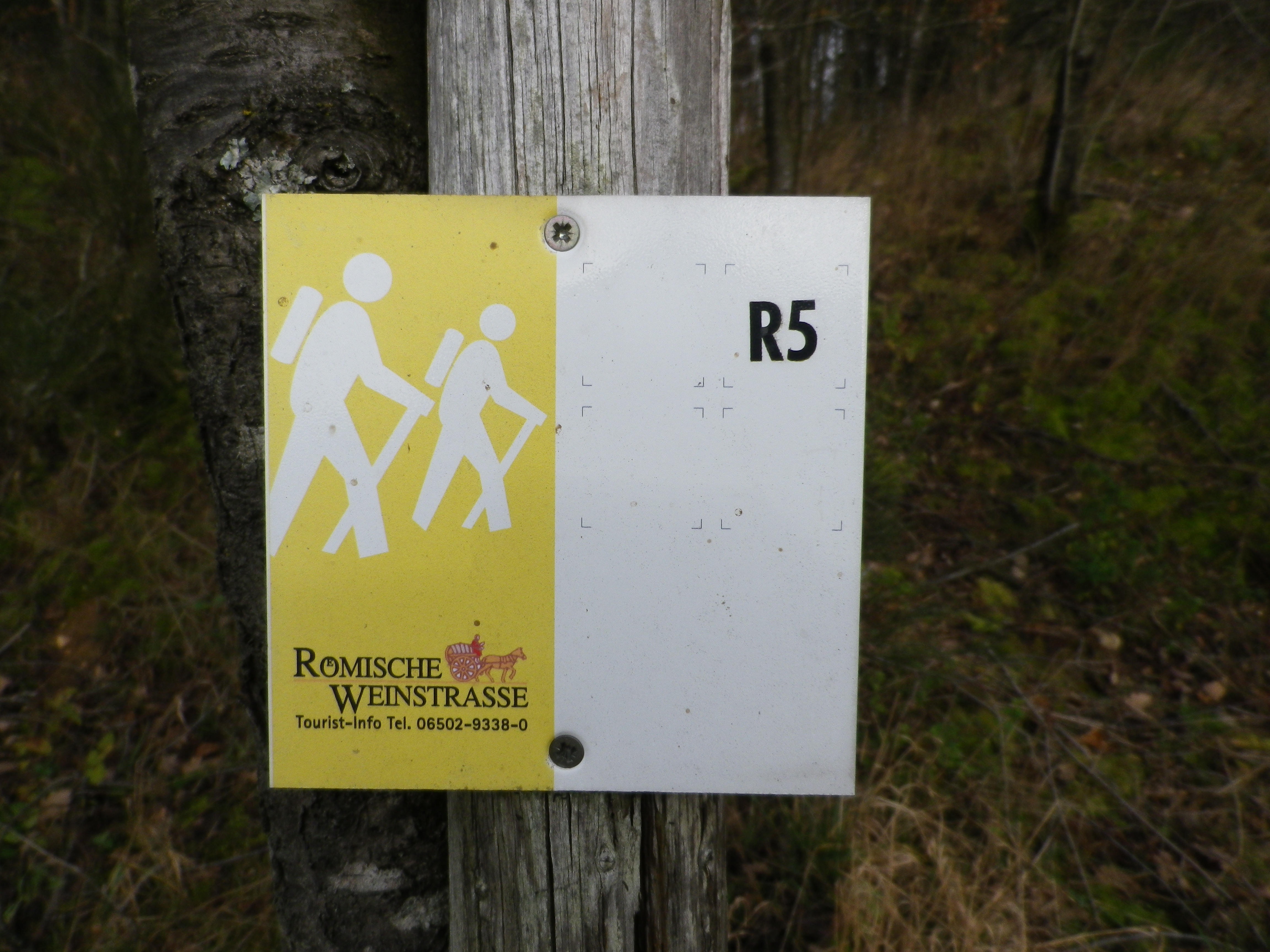
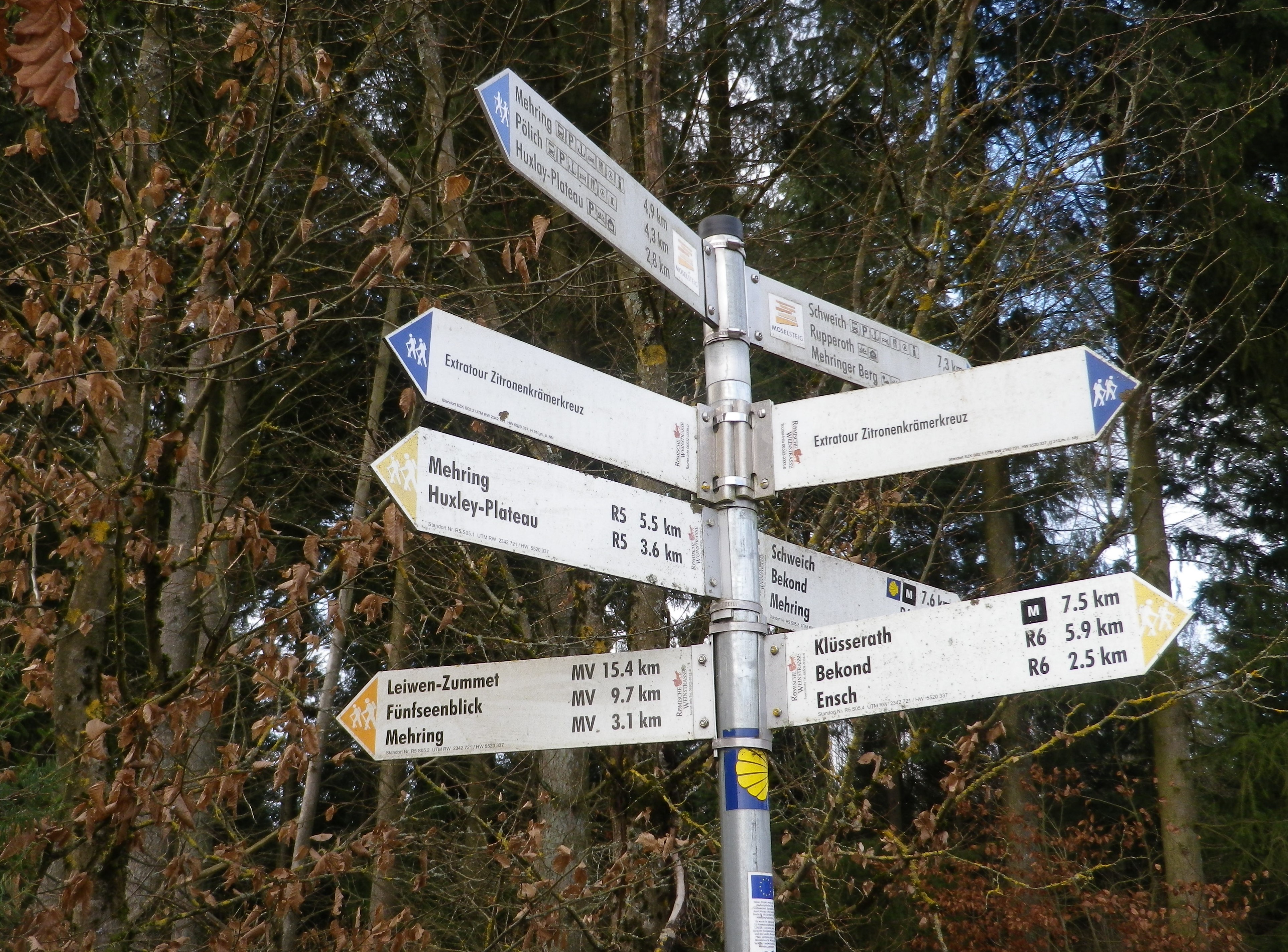
Trail Description: An easy circuit, suitable for most families, that traverses vineyards, pastures, and copses, and passing through Mehring’s village center. While there are plentiful rest spots, snack/bar establishments, and hiking huts to picnic in along the trail, you will want to spend your time admiring the bird’s eye views of the Moselle, and the surrounding hills.
Trailhead:
Mehring: Deierbachstrasse x Schulstr
Parking:
Mehring: a small lot (about 20 cars) at Lintnerstrasse x Deierbachstrasse
Mehring: a small lot downhill from the one above on Deierbachstrasse
Public Transportation Options:
Rail: No train service, per se
Bus: The Moselbahn bus has frequent daytime service from Trier to Mehring, stopping at several villages along the way.
Suggested Stages:
Not applicable
Trail Itinerary-Reference Points: (Counterclockwise)
Mehring: from parking lot at follow Deierbachstr uphill, right onto Schulstr, and stay left on Schulstr uphill to Roemerstr-Goldkuppstr-Bornstr, crossing Am Rebenhang into vineyards; follow the long uphill lane to Huxlay Hutte; follow signs for the Kapelle; then along vineyards to the 10,000 Liter Fass (big wine barrel); follow the tree line, enter the woods, continue to follow the trail leading towards (but not necessarily to): Zitronenkraemerkreuz, Aulkreuz, and Hundsbuckel; heading downhill, the woods end and vineyards begin again; following the Muehlenbach creek past a small pond; past the Dreitaeler Weinkommission, right onto Steinkaul downhill, and right back onto Deierbachstr.
Representative Trail Photos:
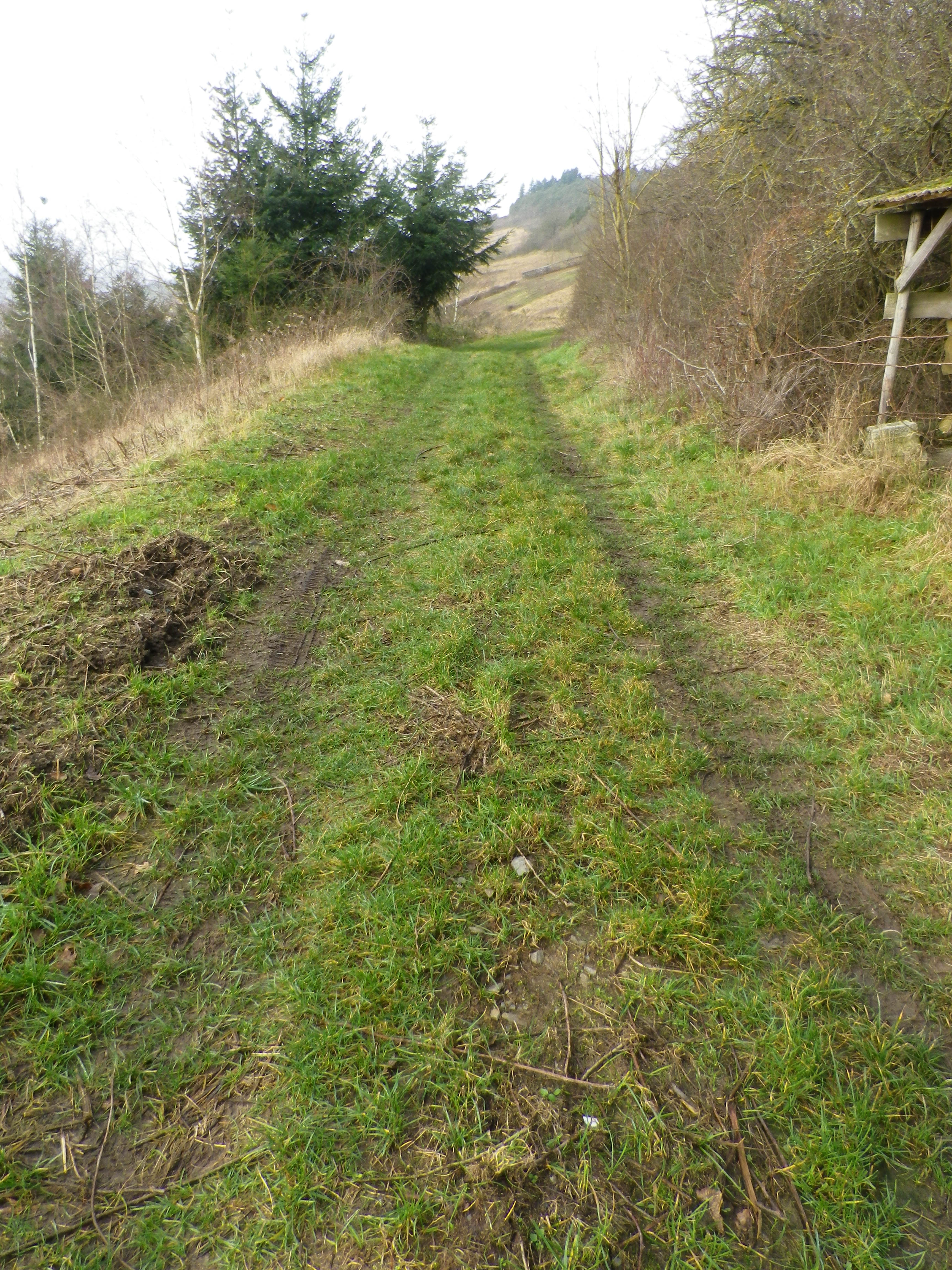
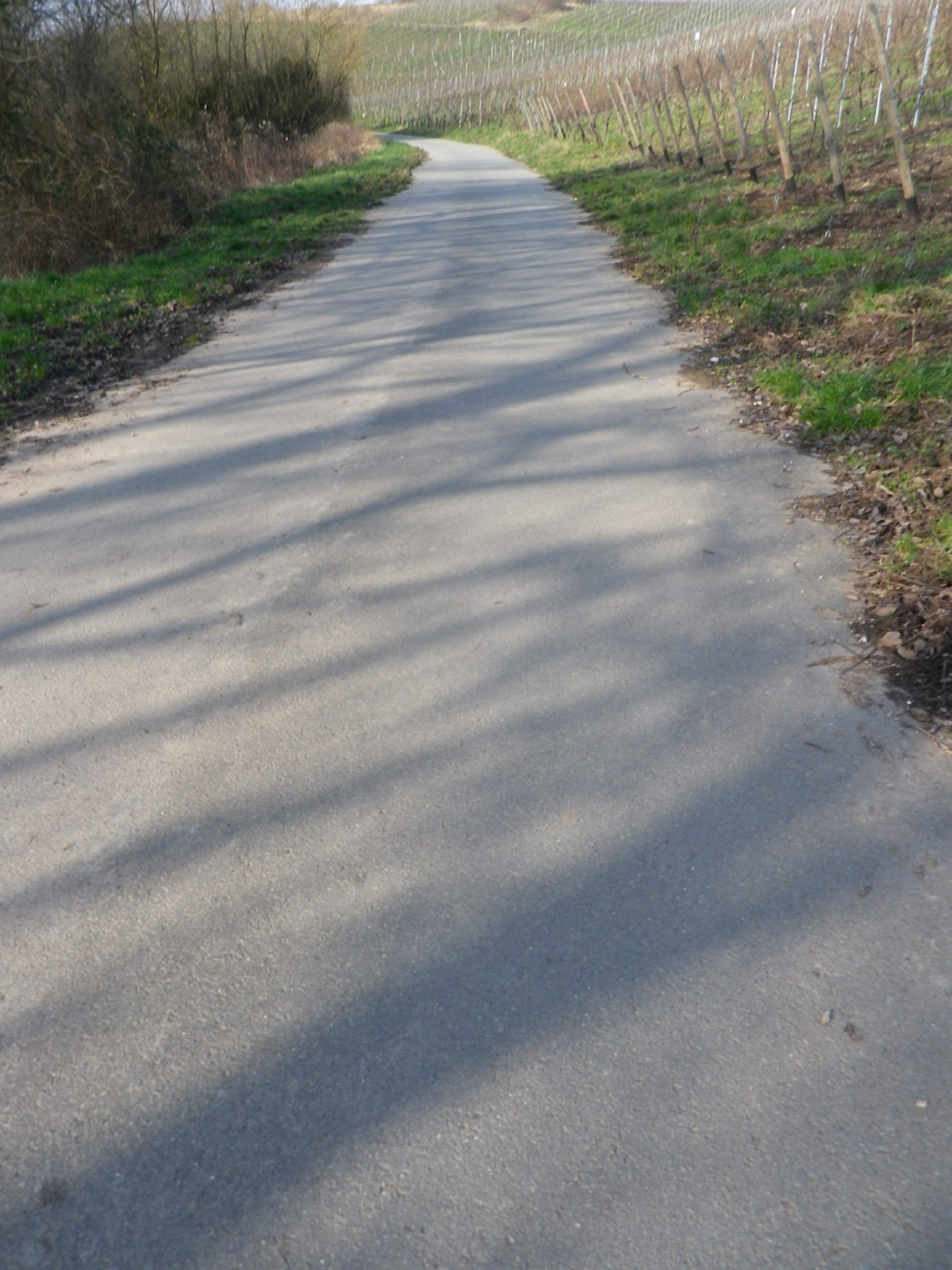
Restrooms:
Mehring (exterior door attached to the town hall/tourist/ Wein u. Heimat Museum building open Apr-Oct (as of Nov 2023))
Attractions on or near Trail:
The Wein and Heimat Museum from April to October; otherwise just lots of scenery and good wine
Tasting along the Trail:
About 20 wine-makers have cellars in Mehring, and at various times, they are open for tastings. In addition to these, and restaurants in the village, there are three wine bars.
Alternative Options:
Hiking: Hiking enthusiasts will find a diverse (circuit, long-distance, family, challenging or easy…) selection of trails, to include wine themed hiking trails, all along the Mosel. Especially popular, albeit not exclusively wine-themed, is the Moselsteig.
Biking: The 248 kilometer Mosel-Radweg (Mosel Bike Trail) begins in Trier passes through Mehring, thence all the way to Koblenz. This beloved bike itinerary, mostly on paved surfaces, and much of it on dedicated bike trail, while not exclusively wine-themed, is a must-do (at-least-once-in-a-lifetime) experience for young and old wine enthusiasts. See the Nutshell here.
Additional Information:
Trail specific: https://www.bergfex.com/sommer/rheinland-pfalz/touren/wanderung/162982,rundwanderweg-mehring–hundsbuckel–huxlay-plateau–mehring-r5/
Comments:
An easily achievable hiking opportunity (and with lots of other options) for almost all visitors to the Moselle valley, to experience a beautiful setting in a world-class wine region, without the crowds.
Gallery June 2021
Heights Above the Heimbach
The name of the trail, the Fuerstenbergblick, in this instance, is a subtle reference to who owned the vineyards on the hills overlooking the Rhine. Not only did the trail lead through the refined vineyards of the Middle Rhine, but it also included views of several castles that the Fuersten, or princes, owned on this lucrative section of the Rhine.
This hike had a lot going for it, beginning with its location. It is about in the center of the UNESCO world-heritage site. Bacharach, and its famous wines, lie just to the north of Niederheimbach, and the well-known wine village of Lorch, with its highly acclaimed wines, faces it from across the river. (It is connected to it by a convenient ferry, making travel between the left and right banks quite convenient.)
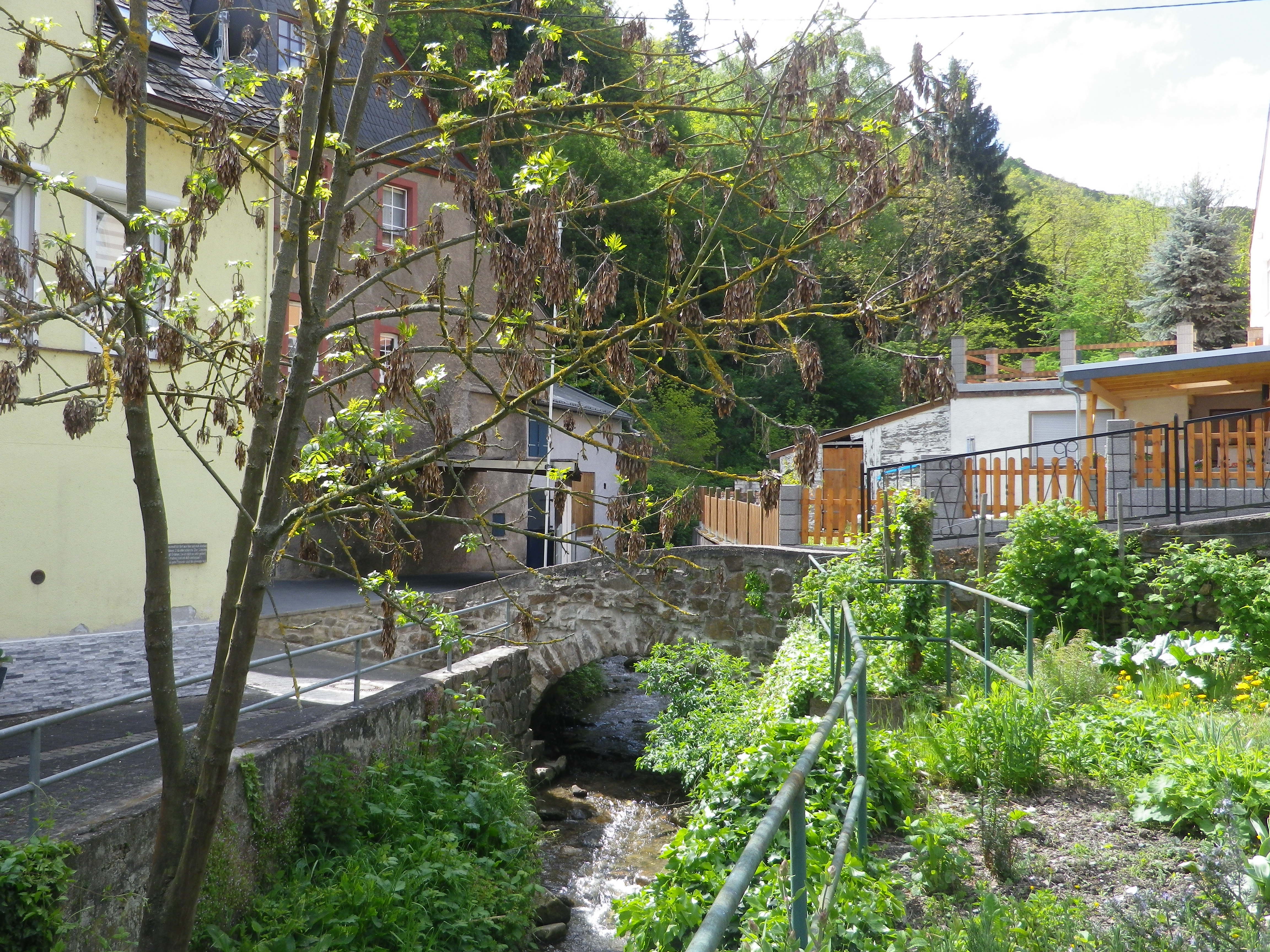
I began in town, and headed inland, up a narrow valley. Soon afterwards, the trail did a 180 degree turn, and I was facing the river, and the delightfully intimate (in size) Hohneck Castle, perched on a riverside promontory on the other side of the little valley.
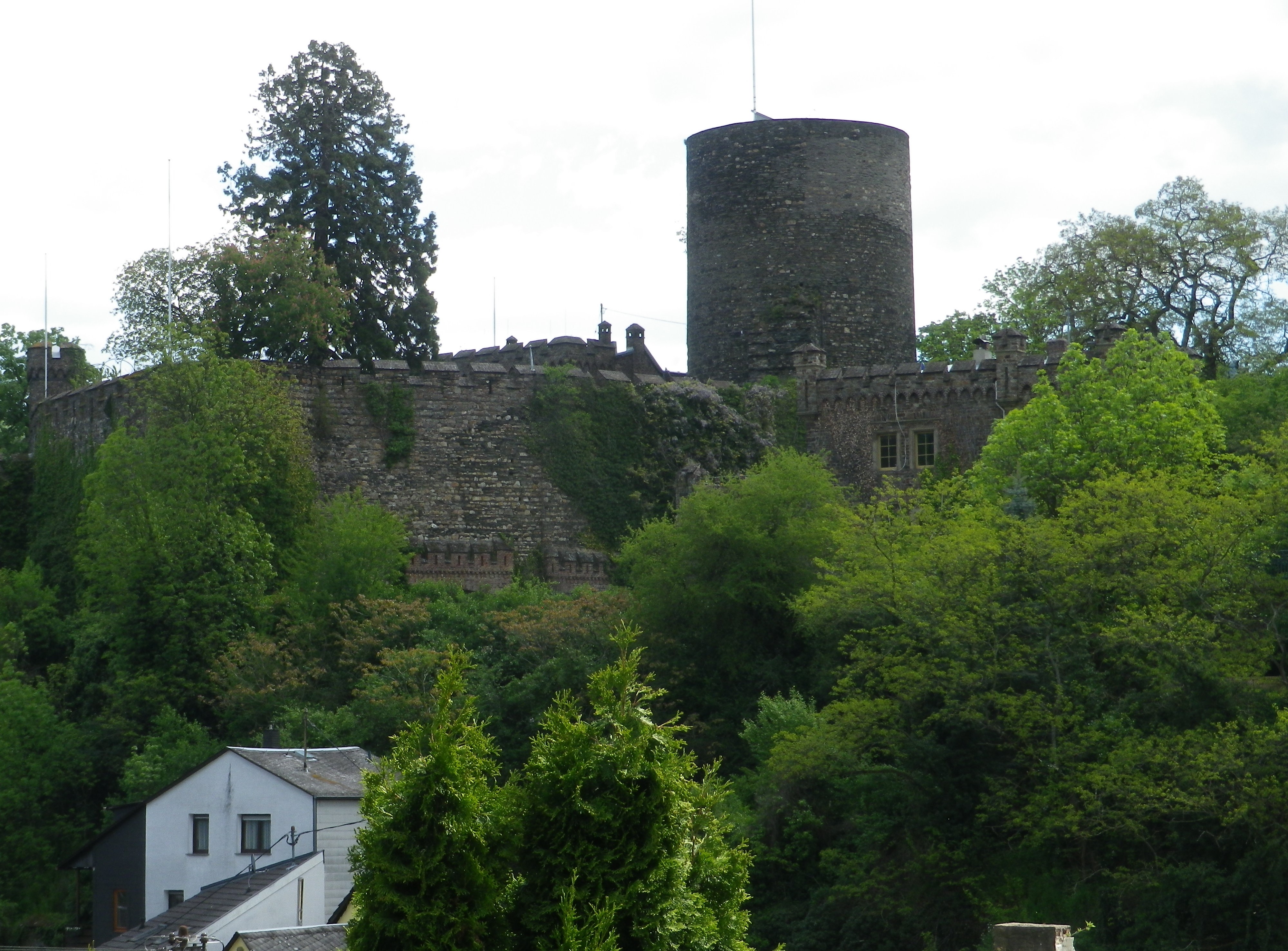
Heading toward the river, but this time on the heights above the little village, I had plenty of opportunity to study the vineyards of Lorch, across the river. I had hiked these vineyards on the magnificent long distance trail, the Riesling Pfad. (See the Nutshell here.) This time, I could see where I had been, and pat myself on the back for the multiple ascents and descents, some rather steep, I made back then.
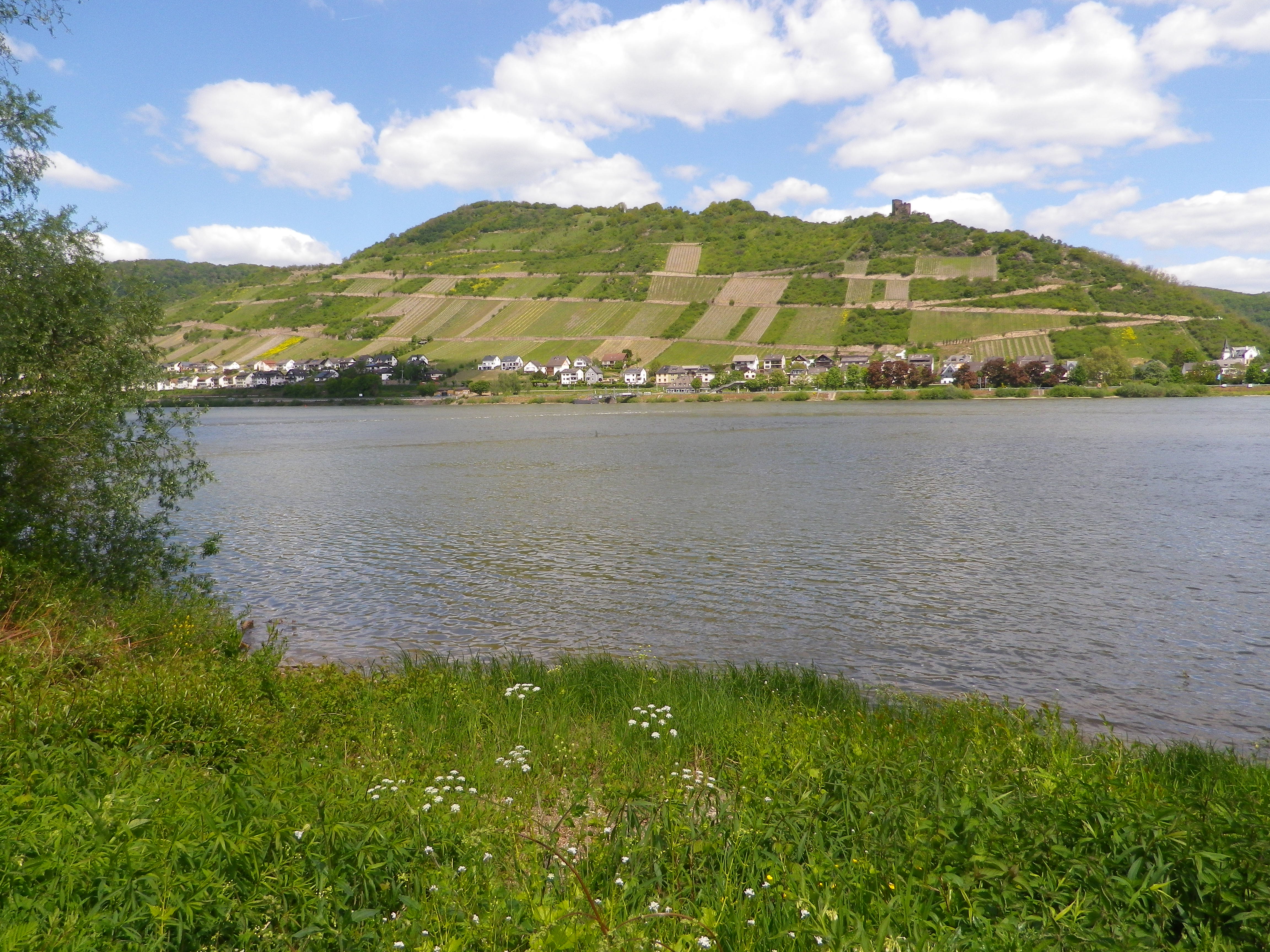
This trail, while neither as long (it is quite short in fact), nor as technically varying or challenging, was a pleasant hike for an afternoon in a quiet, beautiful section of the Middle Rhine. As it continued fairly high above the Rhine, it was easy to enjoy the expansive views while walking along a mostly flat plateau. Views extended downriver to Bacharach, over to Burg Nollig above Lorch, and up river. Photographers and castle-lovers are truly spoiled for choice here!
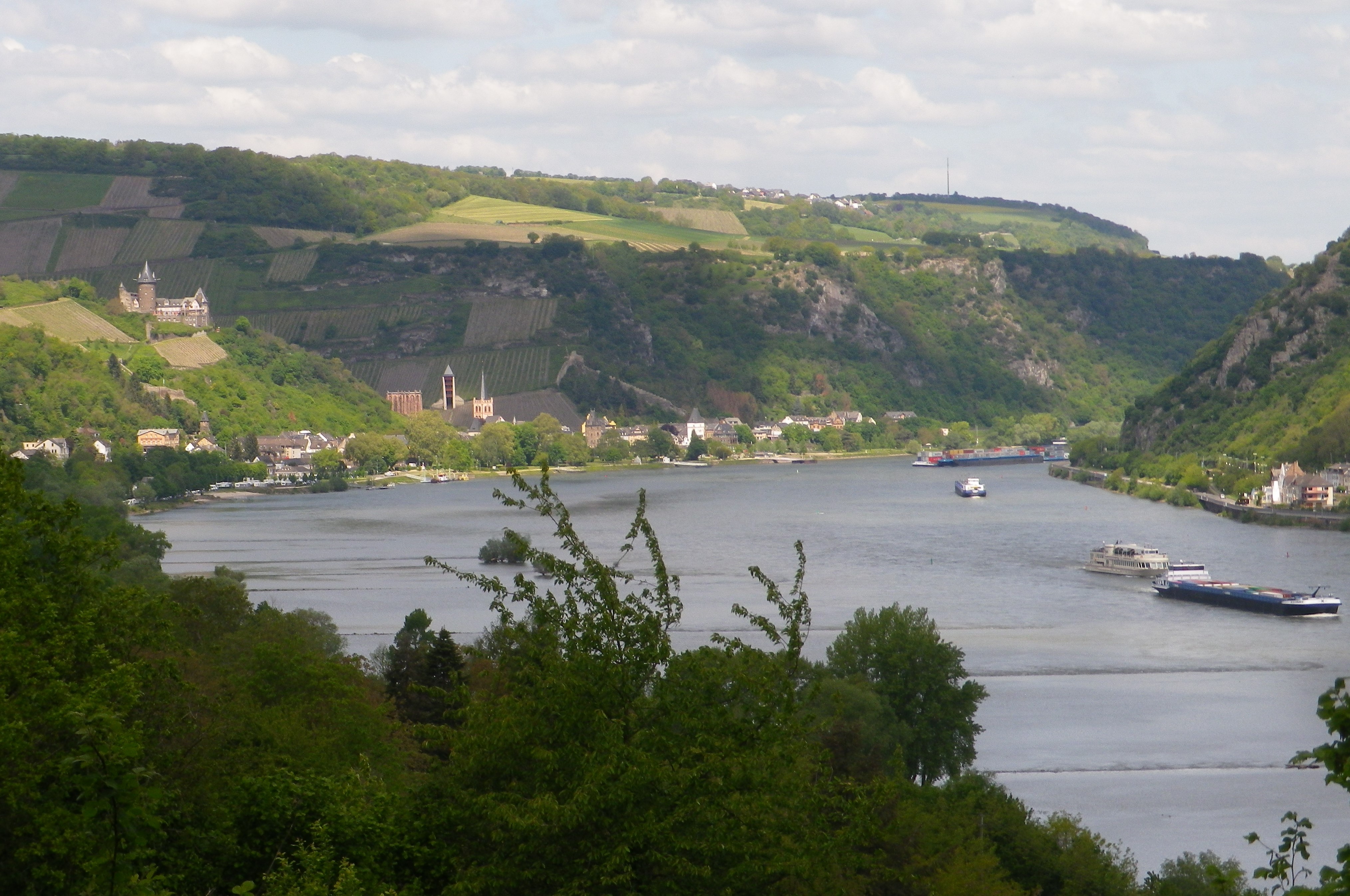
The short descent into and across the Gailsbach valley, was followed by a quick ascent up to the ruined Fuerstenberg Castle. Another castle ruin overlooking the Rhine. You would think I would get tired of them. Crooked ivy-covered walls, where small lizards hide when frightened from their sunny perches, dilapidated masonry, and door lintels to nowhere, pretty much sums up many a ruin. But I never miss an opportunity to explore them.
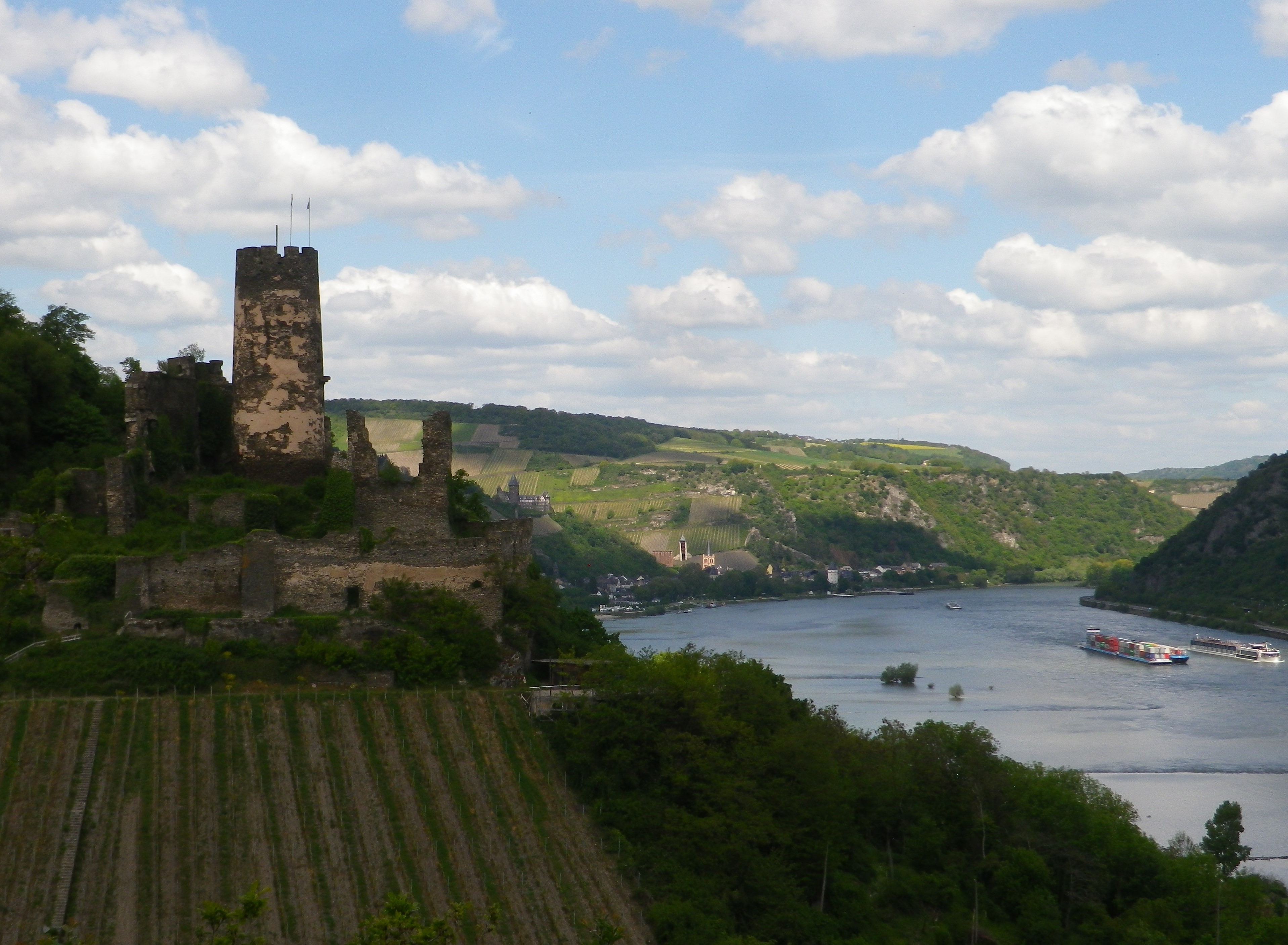
The trail soon turned south to return to Niederheimbach, to complete the circuit. At this point, there is the opportunity to walk along the edge of the Rhine. The trail, which also serves as a bike trail here (so be mindful), was a quiet, flat, nicely tarmacked section, well away from the road. Walking to the sound of lapping water, I soon came to a waterside café-bar, just before the village of Niederheimbach. Miracle of miracles, it was actually open on this non-season afternoon. I stopped, naturally. As I sipped a glass of local wine, and enjoyed the water views, I realized there is no better way to enjoy the Rhine and its wines than hiking along it!
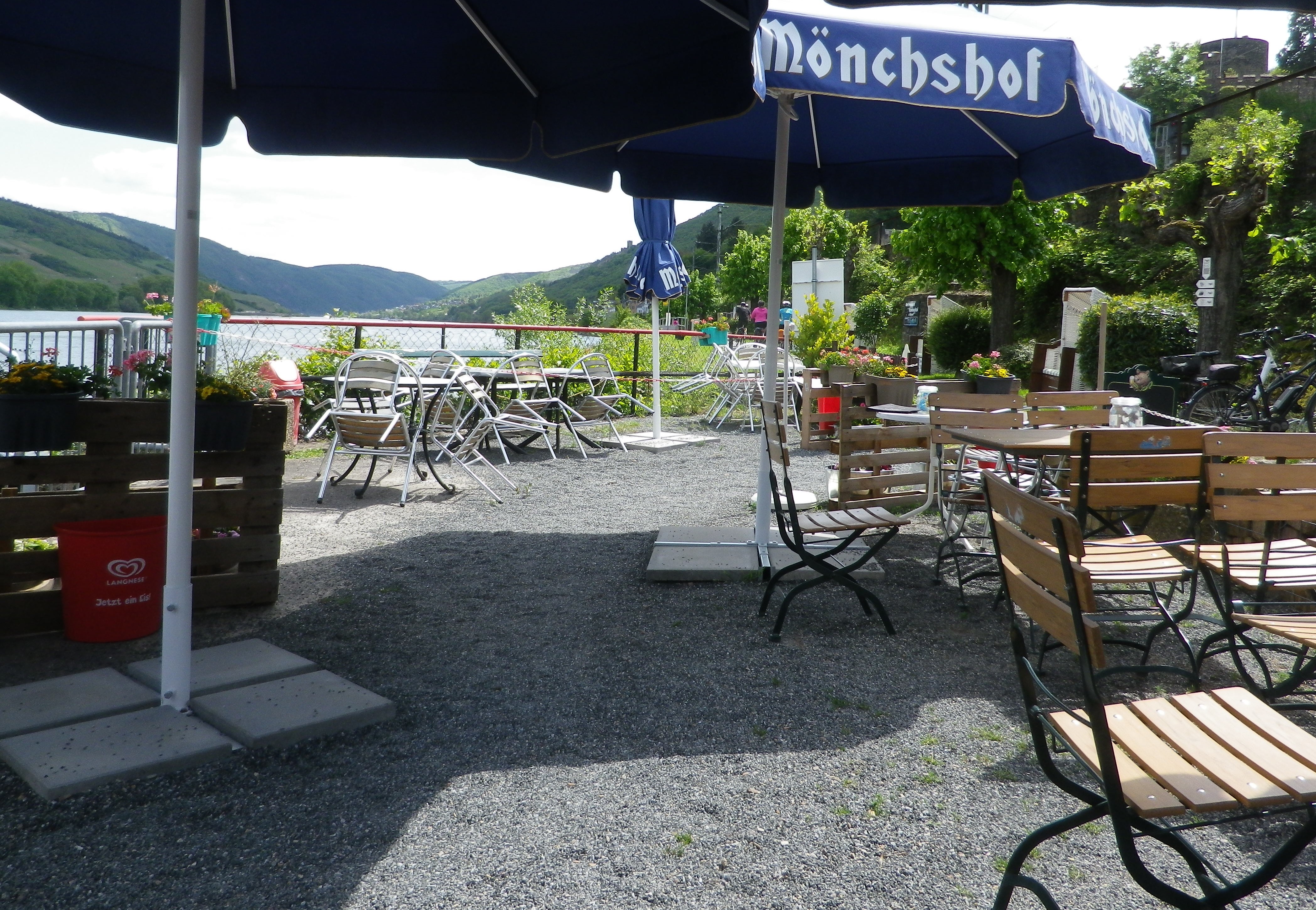
Wine Notes: Mittelrhein Reichenstein
What I Learned
The Mittelrhein (Middle Rhine) is famous for its castle ruins, towering cliffs, and dramatic oxbow bends along the river through this section of it. The Upper Middle Rhine is now a UNESCO World Heritage site. It begins in Koblenz, and continues to Bingen.
This also defines the wine region known as the Mittelrhein. Unlike other wine regions on the Rhine, this region covers both banks of the river (beginning north of Lorchhausen, which joins the Rheingau region). Many areas of the Upper Middle Rhine do not produce wine: the topography and geology just aren’t suitable or practicable, even for growing other crops. That just makes the vineyards along this section of the Rhine even more esteemed.
On the left bank, dark slate begins to predominate in the soil around Boppard, and continues upriver until just outside Trechtingshausen. This hard rock shapes the river as well, and its many twists and turns provide optimal sun exposure for some slopes, like the famous vineyard of Bopparder Hamm, while depriving others of much sun at all just around the next bend.
Because of the different geological conditions, the Mittelrhein region is divided into different “Grosslage,” or growing areas, each containing some specifically named vineyards. This hike covered the area around mostly Oberheimbach, which falls with the Grosslage of Schloss Reichenstein, the name of a brooding castle ruin located about three miles upriver in Trechtingshausen. Well-known Nieder/Ober -heimbach vineyards include Niederheimbacher Froher Weingarten, Oberheimbacher Sonne, Oberheimbacher Klosterberg, and my personal favorite: the Oberheimbacher Wahrheit (it means “Truth”), which says all you need to know about the true expression of the terroir in the wines from here.
What I Tasted
2017 Riesling Weinberg Schloesschen, Spaetlese, Trocken, Deutscher Qualitaetswein, Weingut Juergen Stassen (Oberheimbach): A dry white wine with medium gold color, a mineral and slightly fruity nose, with green gooseberry and mineral flavors; medium plus acidity with a tart finish.
2015 Riesling, Classic, Trocken, Deutscher Qualitaetswein, Weingut Eisenbach-Korn (Oberheimbach): A dry white wine with medium plus gold color, a spicy, nose with hints of turpentine and lipstick; with spicy and fruity flavors, medium acidity with a smooth, but tart finish; very well balanced overall.
2013 Weisser Riesling, Niederheimbacher Froher Weingarten, Qualitaetswein, trocken, Fendel: A dry white wine with a medium gold color: a well-balanced, slightly floral and fruity tasting wine with a pleasant minerality to it.
Fuerstenbergblick: Trail in a Nutshell
Trail Name: Nr 22 – Fuerstenbergblick
Trail Type: Short distance circuit trail; well-maintained and mostly paved or hard-packed earthen trail, marking on the trail is mostly good, but not always exclusively specific to this trail as other trails follow along it as well.
Length:
Total – 7 kilometers/4.3 miles
Convenient to: Bingen, or Koblenz, Germany
Marking: Nr 22, or follow signs to next itinerary point
Trail Description: This is an easy trail through a little visited area of the famous Middle Rhine. It passes through a couple of wooded areas, but mostly vineyards, with clear views of the vineyards and castles on the opposite (and more visited) side of the Rhine, and a lovely riverside walk to close the circuit.
Trailhead:
Niederheimbach, Rheinstrasse riverside walking path
Parking:
Niederheimbach: A few street-side places where parking is not prohibited along the Rheinstrasse or Heimbachtal streets
Public Transportation Options:
Rail: Very frequent train service (DeutscheBahn (DB) regional train RB26) connects Niederheimbach with Mainz to the south, or Cologne to the north with stops all along the Mittel Rhein including Bingen, Boppard, St Goar, Koblenz, amongst others.
Bus: See the Rhein-Naehe Nahverkehrsverbund (RNN) website for details of bus travel through this area
Suggested Stages: Not applicable
Trail Itinerary-Reference Points: (Clockwise)
Niederheimbach: Heimbachtal, then turn up to Rheinblick, vineyards, lookout point “Tempelchen”, woods, Rheindiebach: Cross Rheingoldstrasse/K27, vineyards, to and past Burg Fuerstenberg ruins, pass above the cemetery, Rheingoldstr, Mainzerstr, pass under B9 and train tracks, continue on the waterside path back to Niederheimbach
Representative Trail Photos:
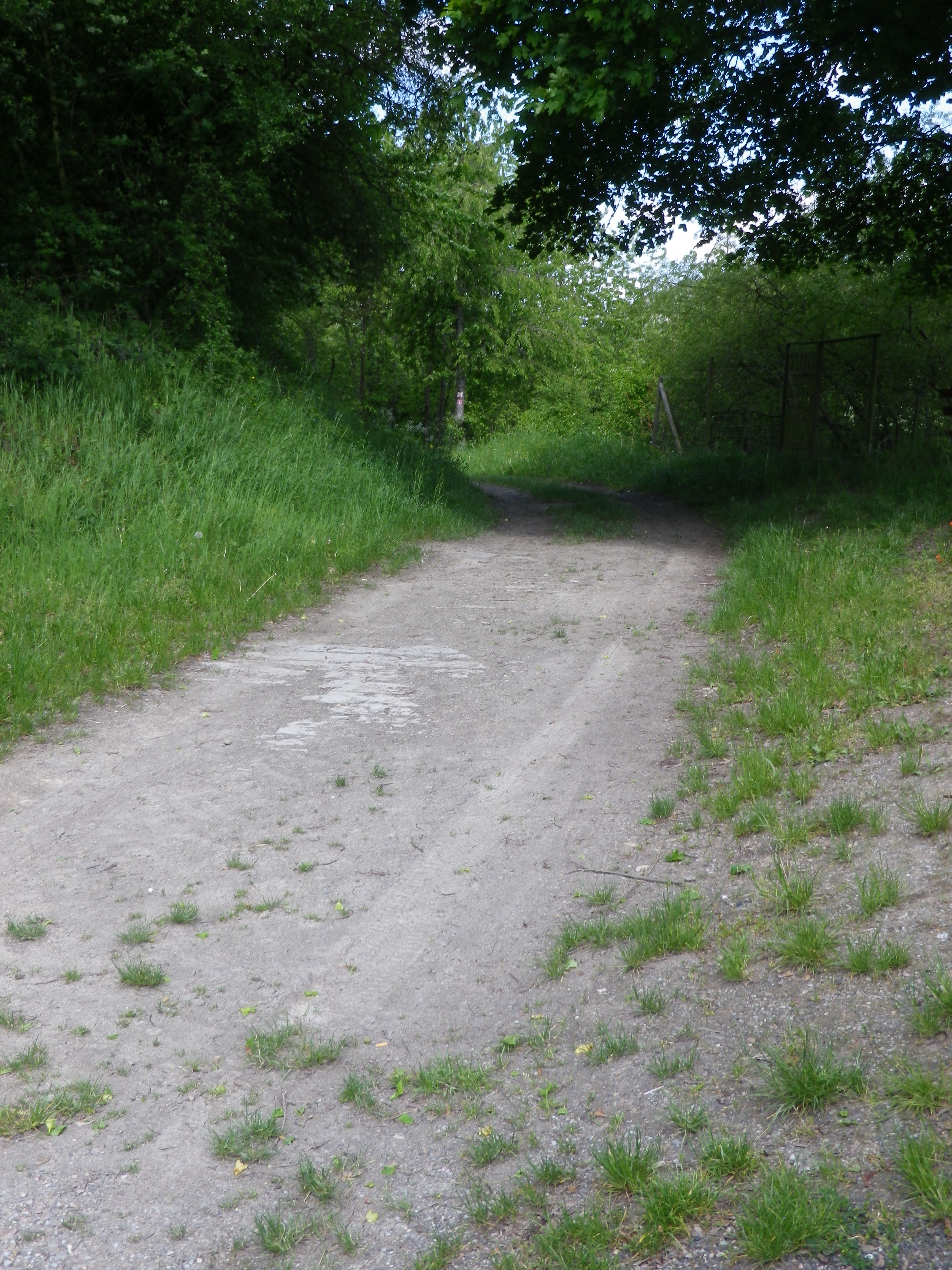
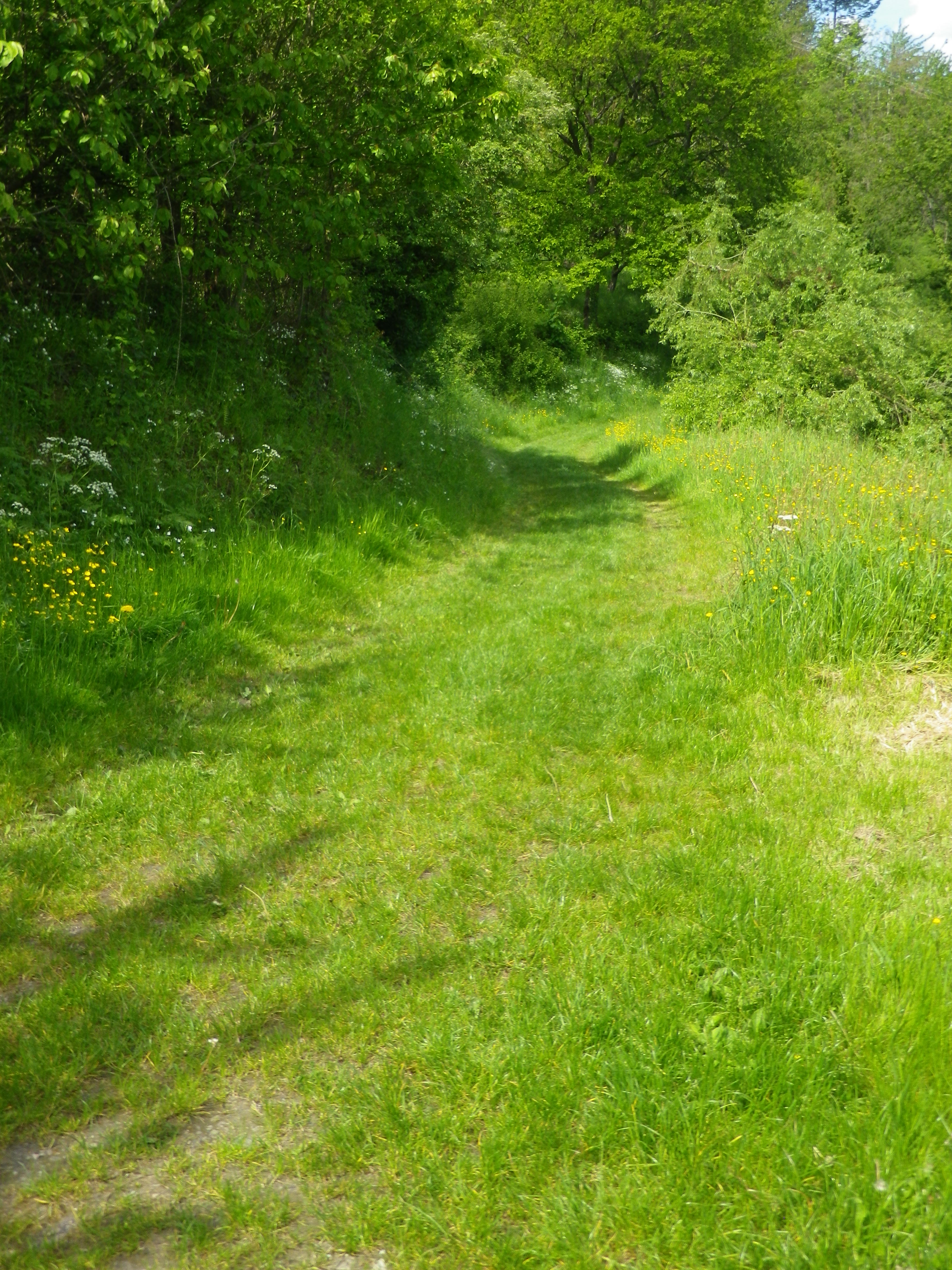
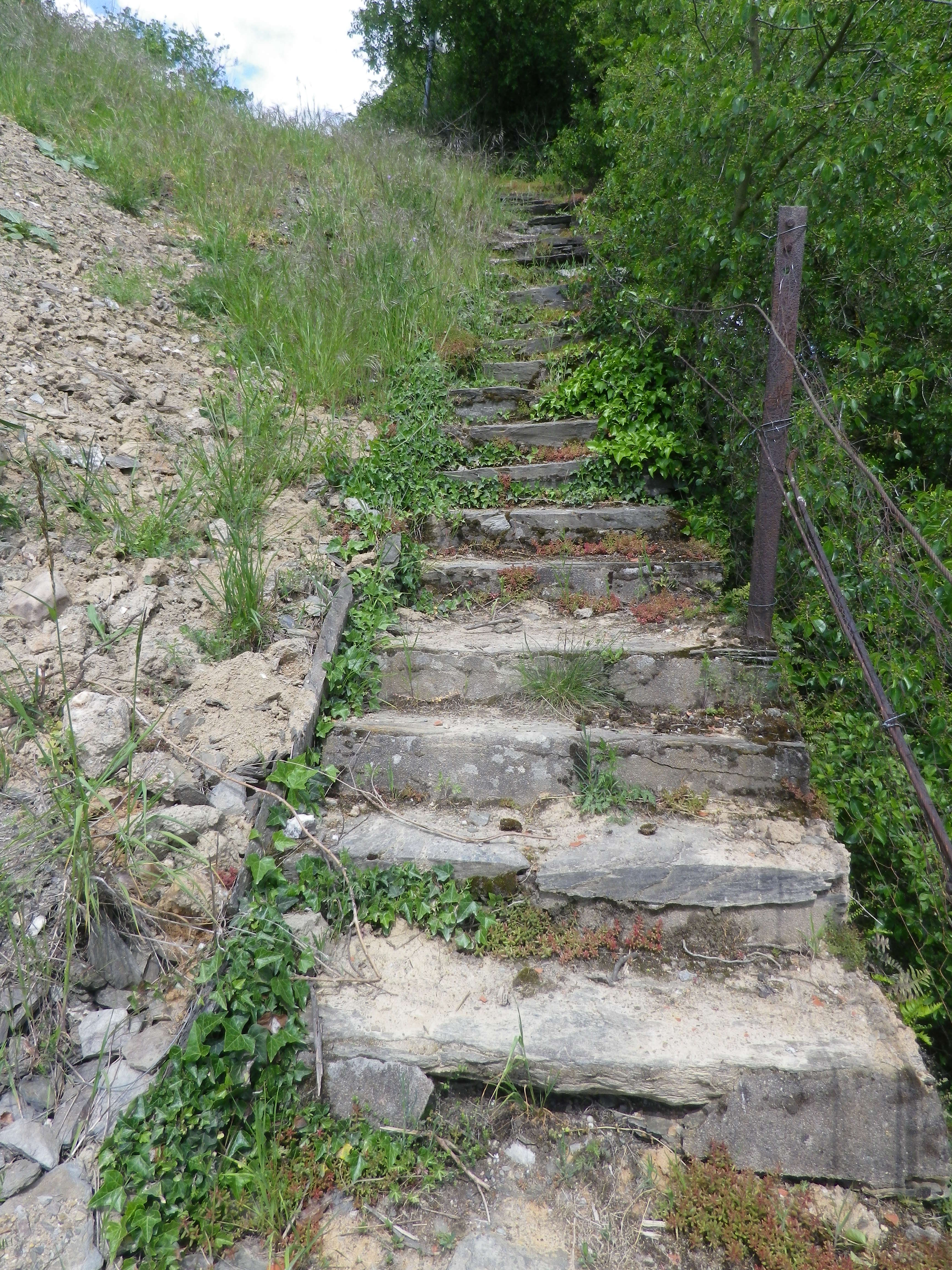
Restrooms:
Rheindiebach: along the river, just north of the pedestrian underpass
Attractions on or near Trail:
Just lots of iconic Rhine River scenery!
Tasting along the Trail:
Niederheimbach and Oberheimbach both have guesthouses and restaurants that serve local wines. Niederheimbach even has one right along the river!
Alternative Options:
Hiking: Reblausweg (Nr 13) / Route 1 Panoramaweg, an 8 kilometer circuit trail beginning/ending at Niederheimbach. See the Nutshell here.
Biking: Rheinradweg, is a multi-day tour following the Rhine, but an easy day trip, with lots of stops for photos, is from Koblenz to Bingen am Rhein, or vice versus. It passes through Niederheimbach, which is one of the trains stops along the river route. See the Nutshell here.
Additional Information:
Regional: https://www.romantischer-rhein.de/ and https://niederheimbach.welterbe-mittelrheintal.de/
Trail specific: https://www.outdooractive.com/de/route/wanderung/romantischer-rhein/nhb-nr.-22-fuerstenbergblick-rundwanderweg/116090787/ or https://www.niederheimbach.info/media/files/nhb-wanderweg_022_k-2022-07.pdf
Comments:
Short, easy, but lovely.
Gallery November 2022
Trails Along the Moselle
To many wine lovers, the Middle Rhine means exceptional Riesling. To me, the lower Moselle means scenery that is just as dramatic, in a region that is far quieter, with Riesling that is just as good. All that adds up to a wonderful vacation in the heart of one of Germany’s most well-known wine regions.
One of the great things about the Moselle valley is that most towns are all connected by a rail system on the left bank. Hence, going from Koblenz (on the Rhine), upriver to Trier, is both convenient and relatively inexpensive. I began in Lehmen, and hiked, on a variety of paths to Loef, where I spent the night. While I had completed hikes in Hatzenport (just one village away upriver), and another in Winningen, a few miles downriver, I found this short stretch of the valley particularly attractive. Not only were there several hiking trails to choose from (see the accompanying Nutshell here), the scenery was striking, the restaurants very good, and the Rieslings delicious, for less than many comparable Middle Rhine wines.
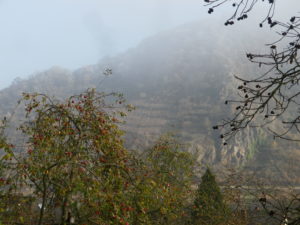
The trails start in the villages along the river, and climb steeply up the cliffs behind them. Due to the steepness of the slopes, the vineyards are small and steep, only rising to a certain point. Above them is forested area, and between it and further above, the trail runs, sometimes narrow and twisting over rock and tree roots, with clear views up and down the valley.
